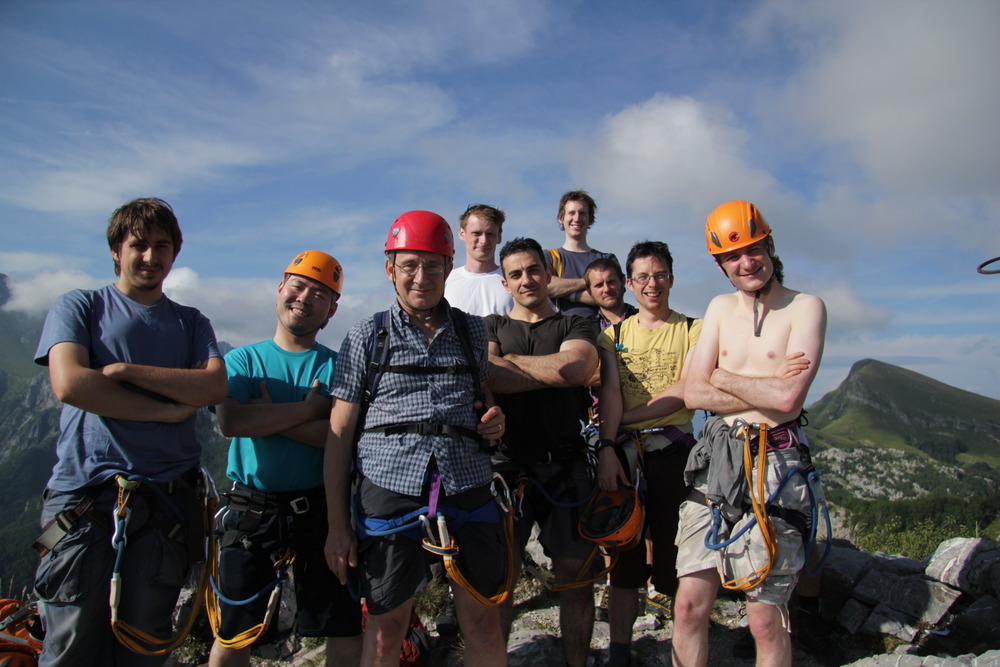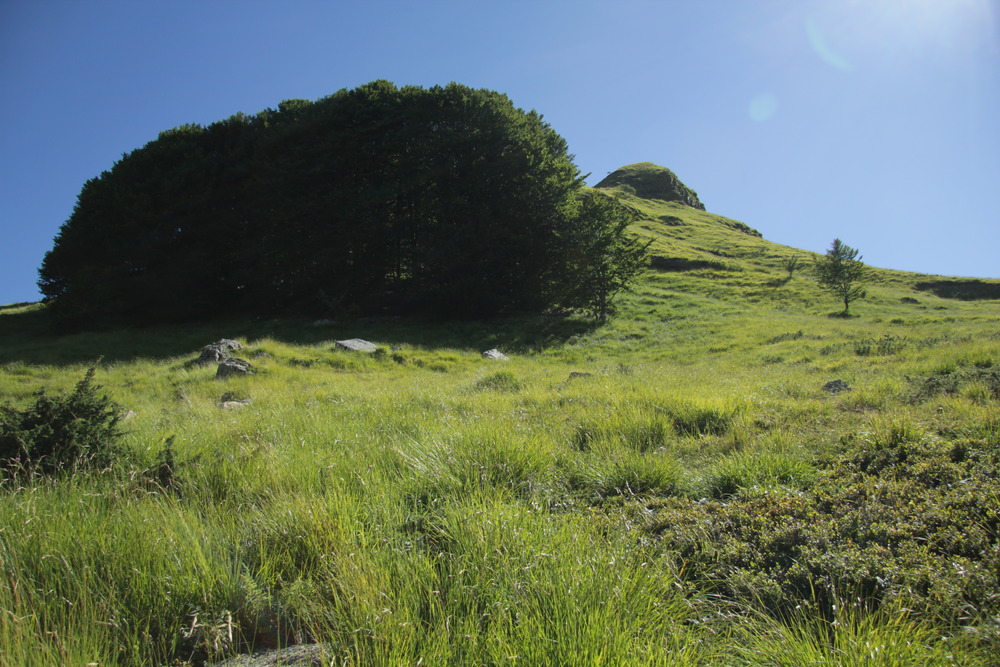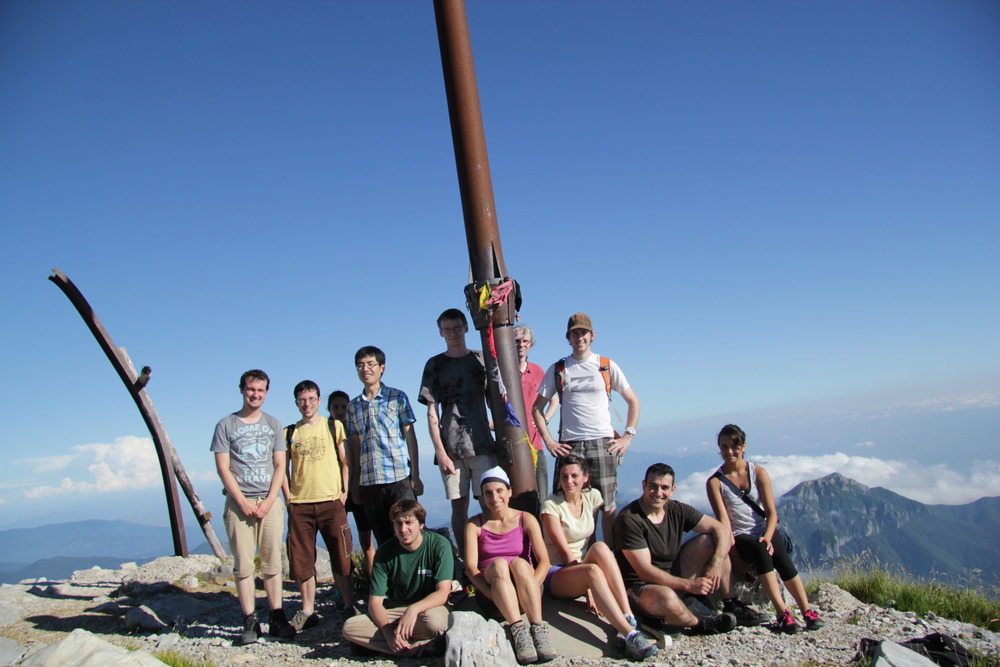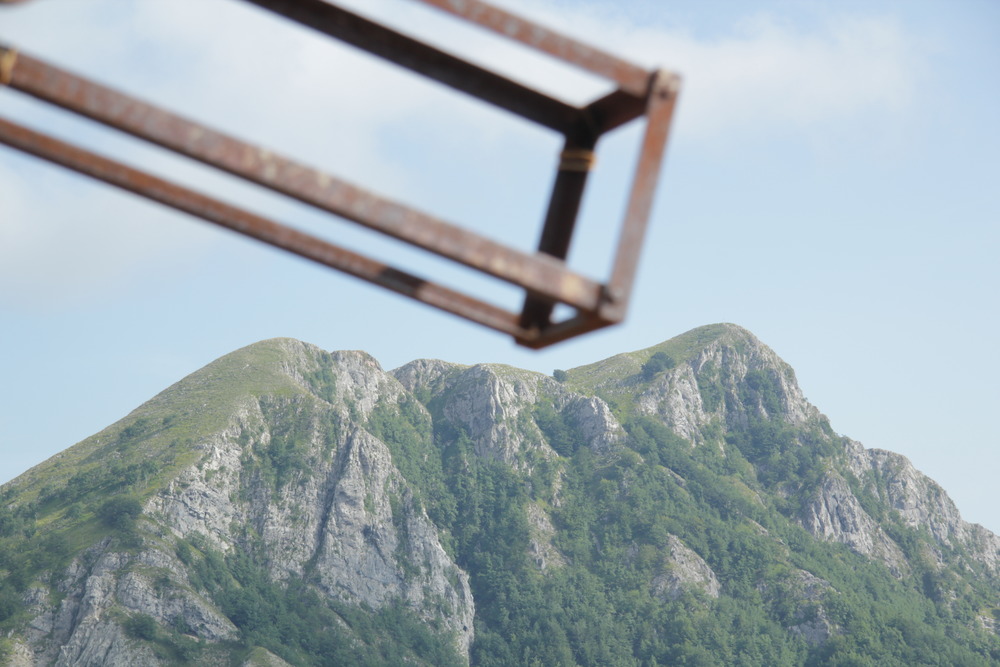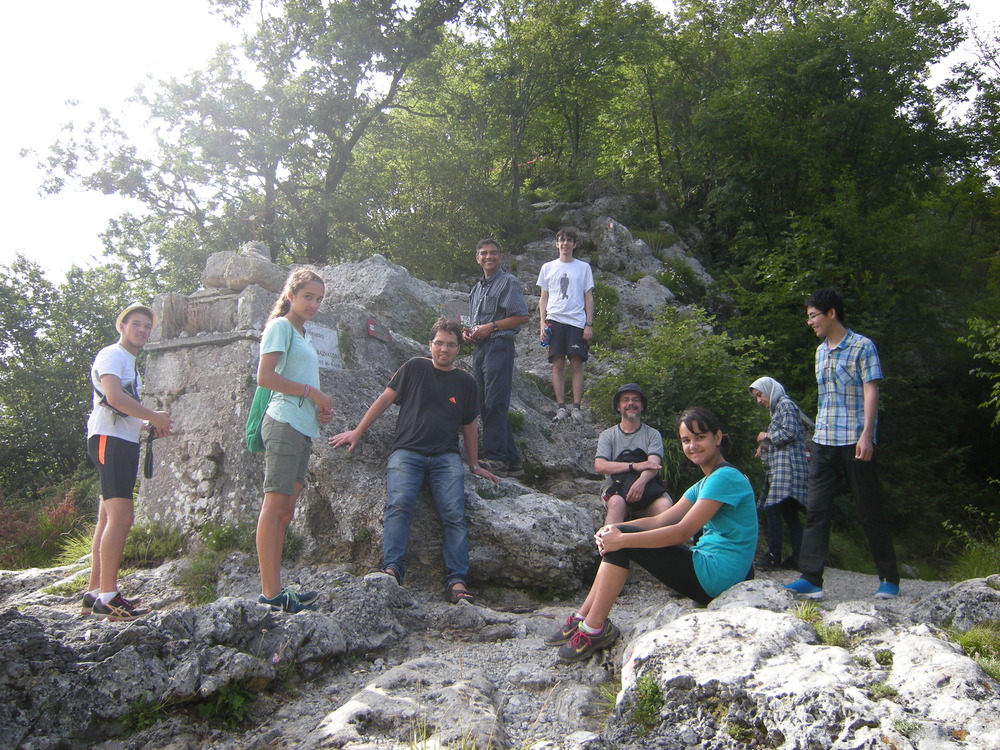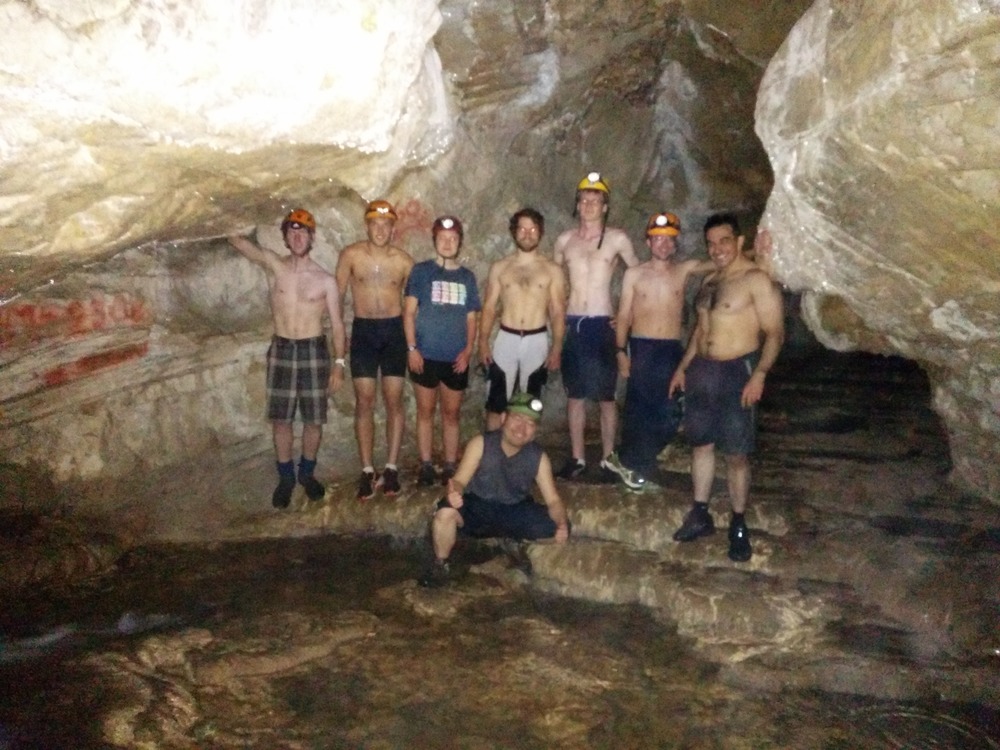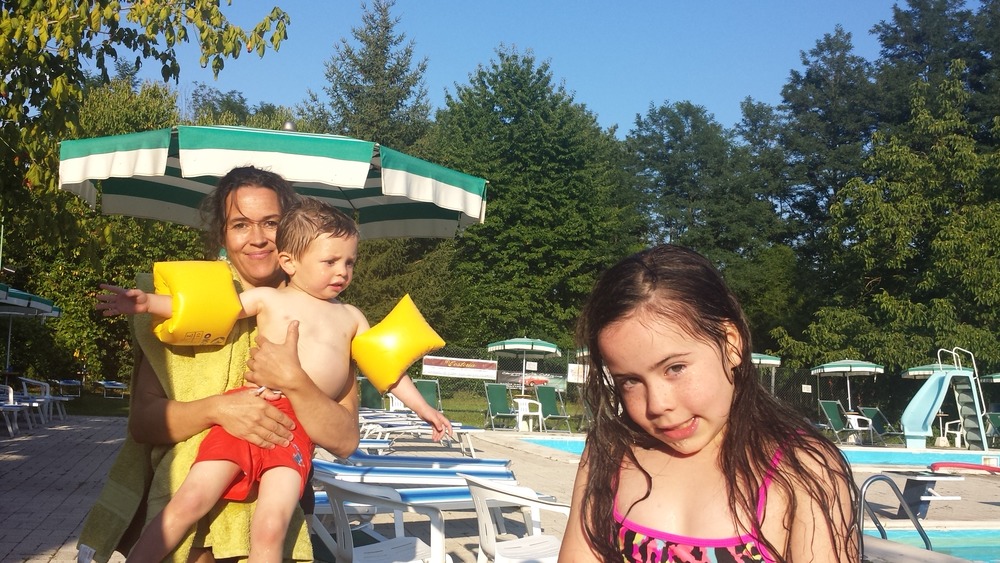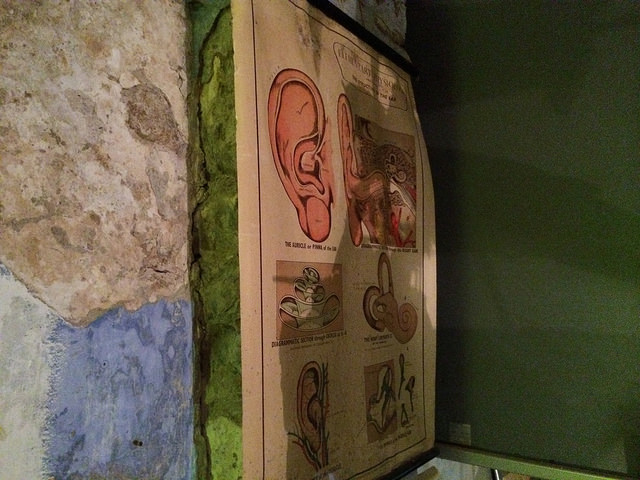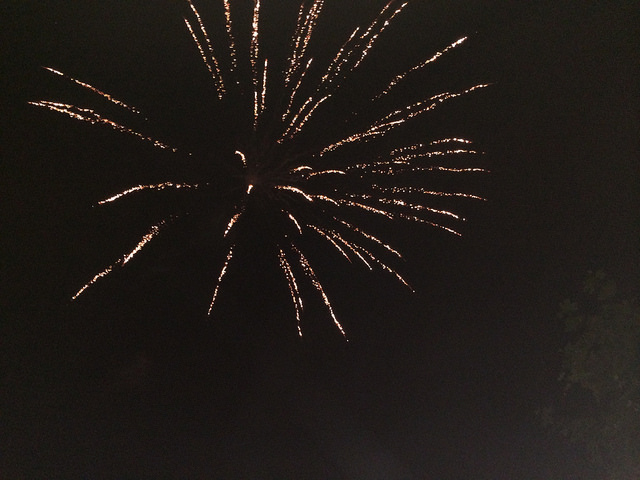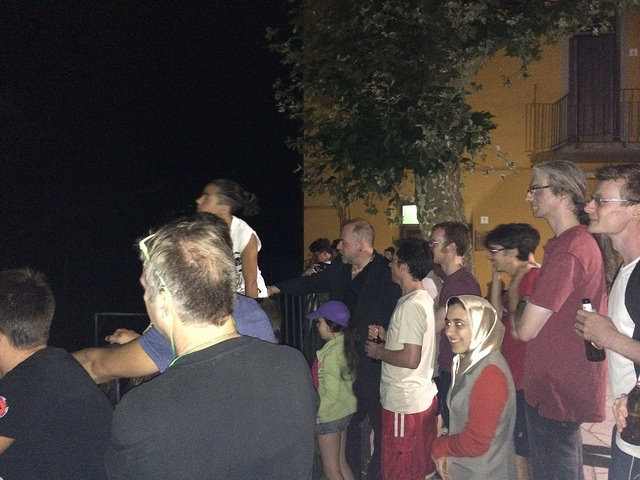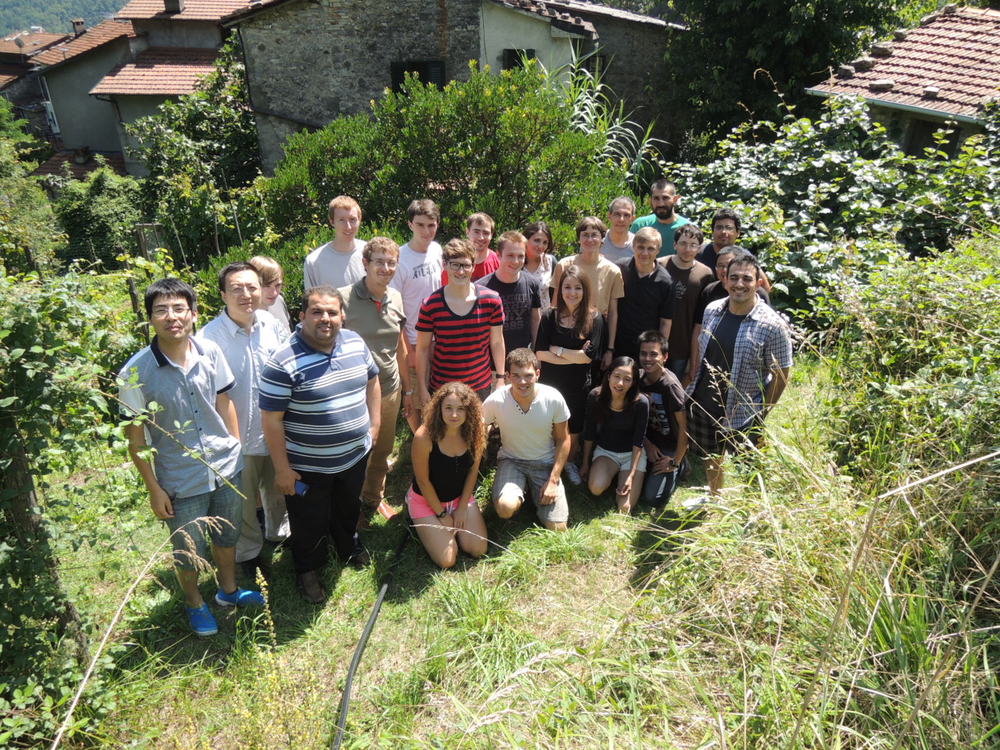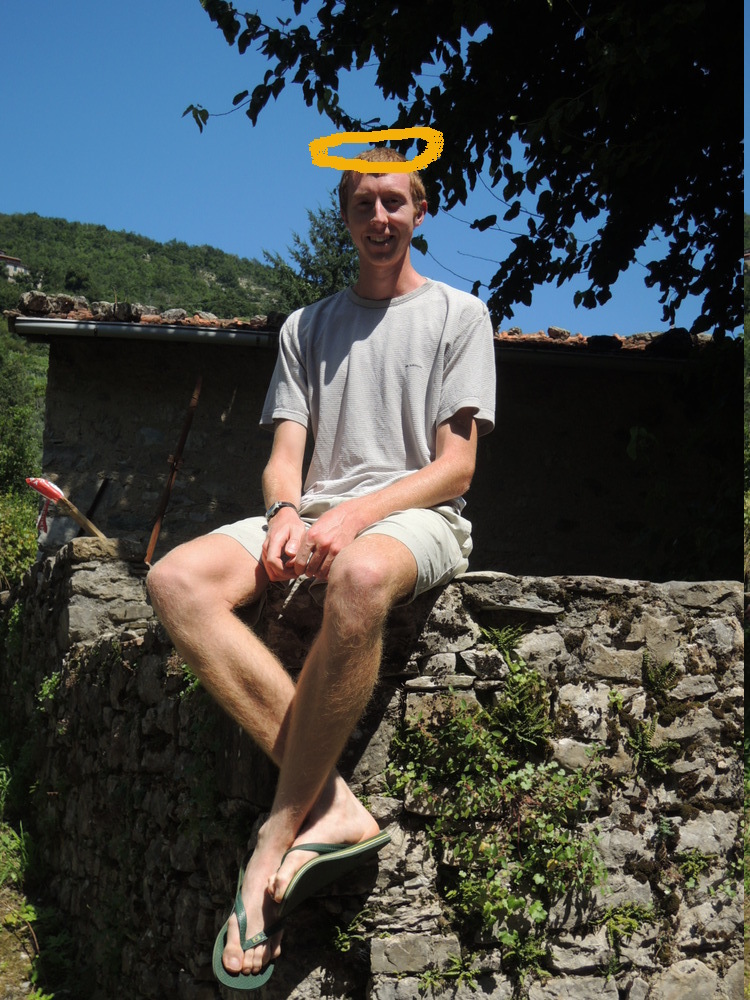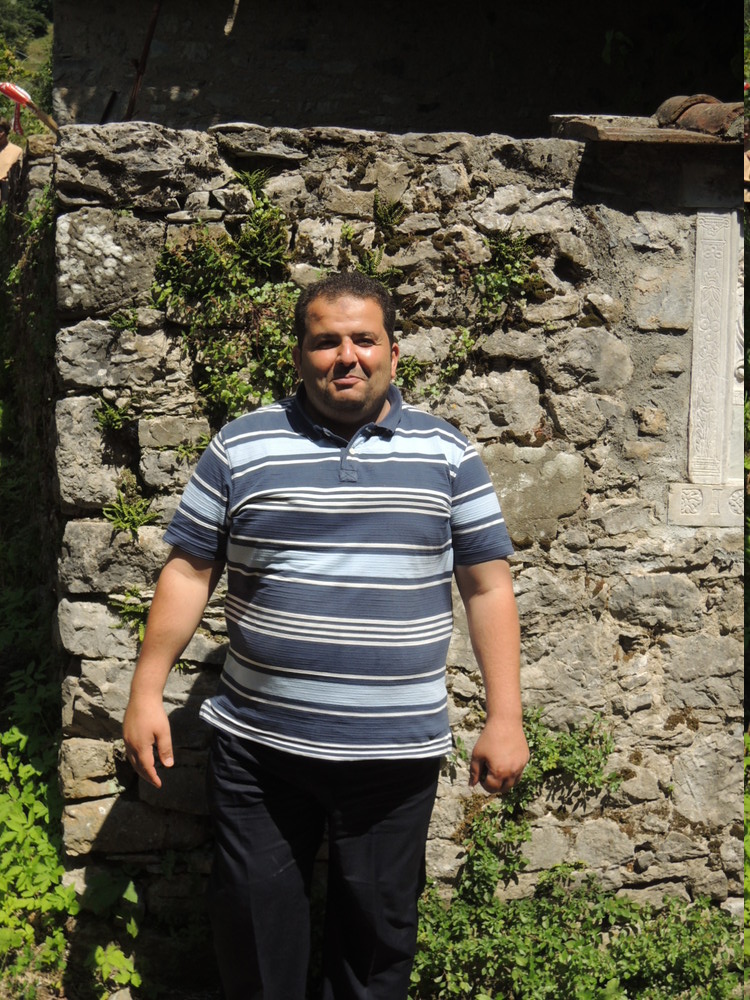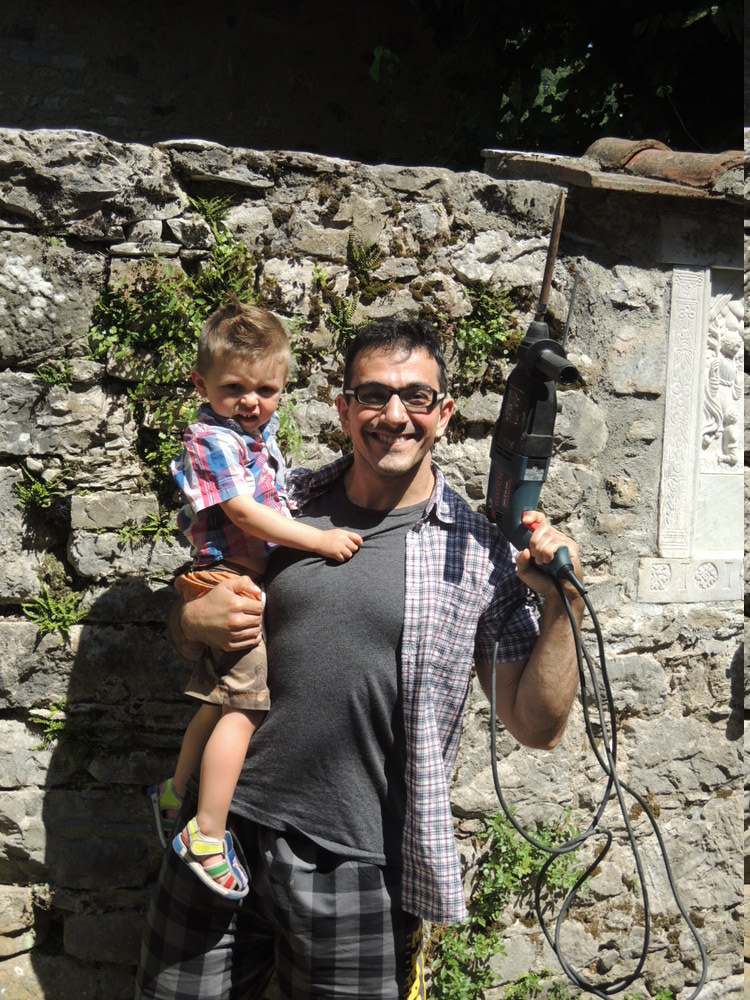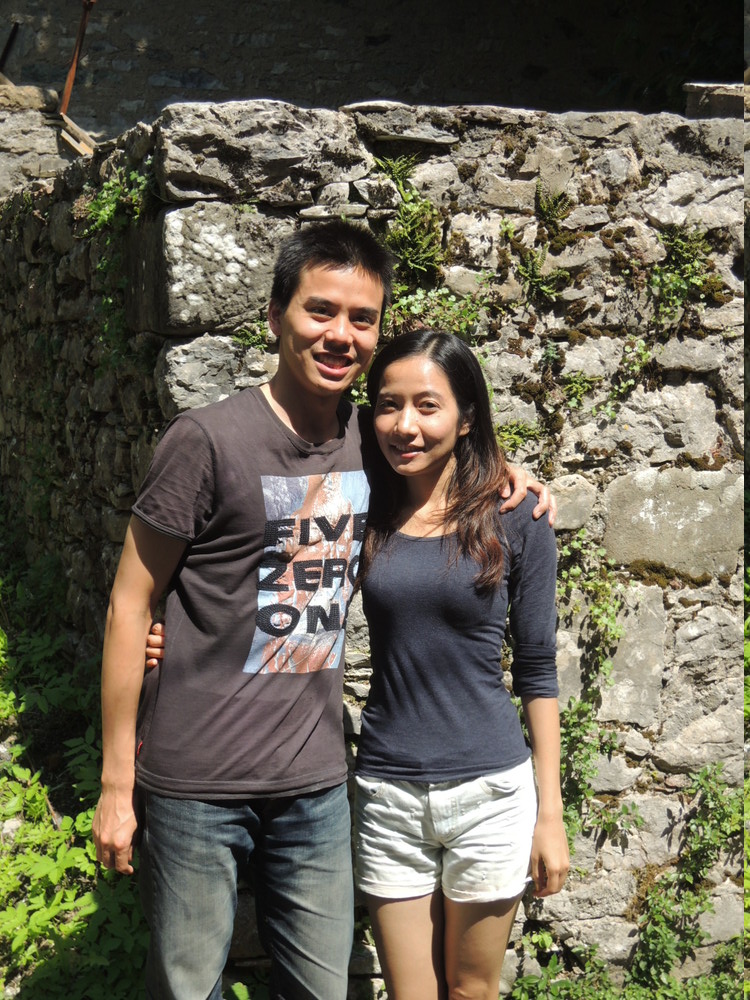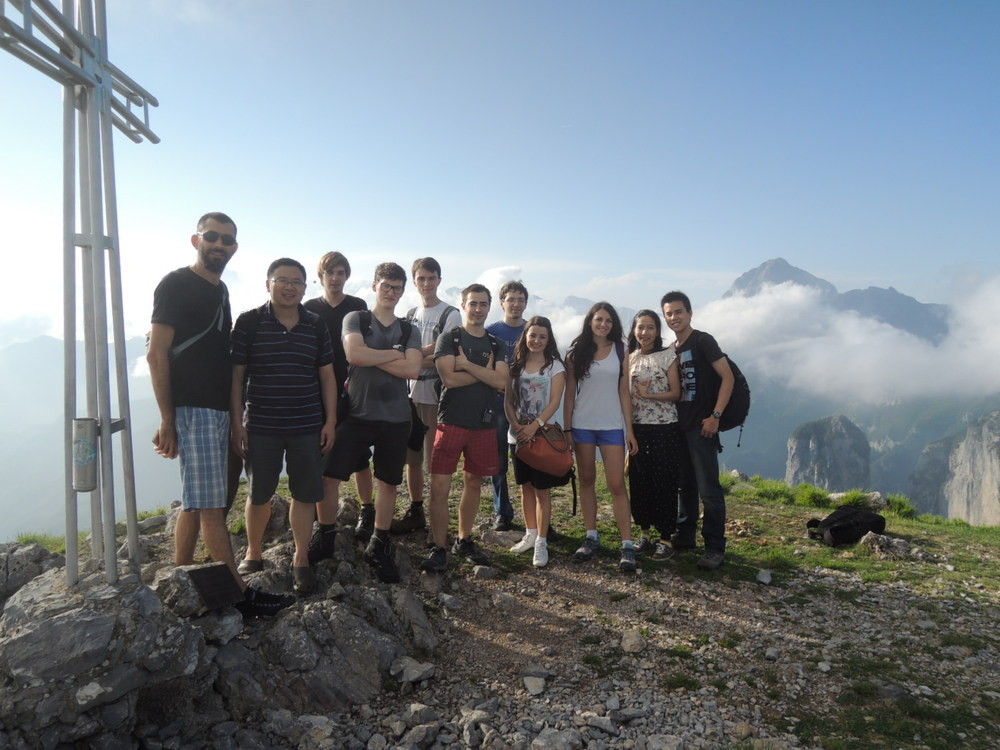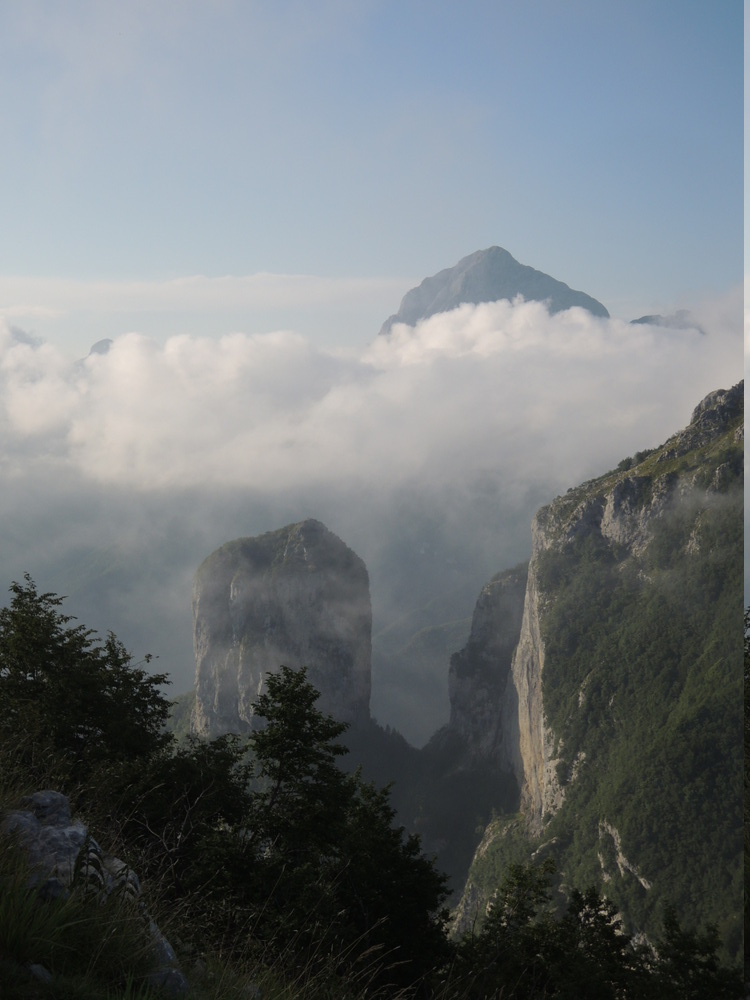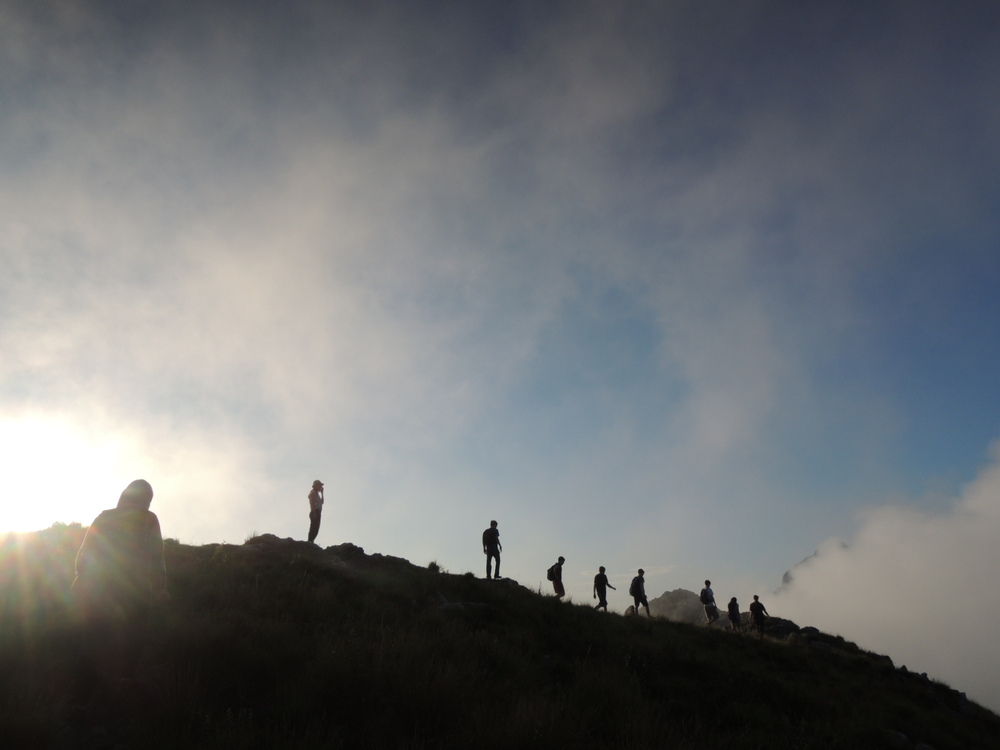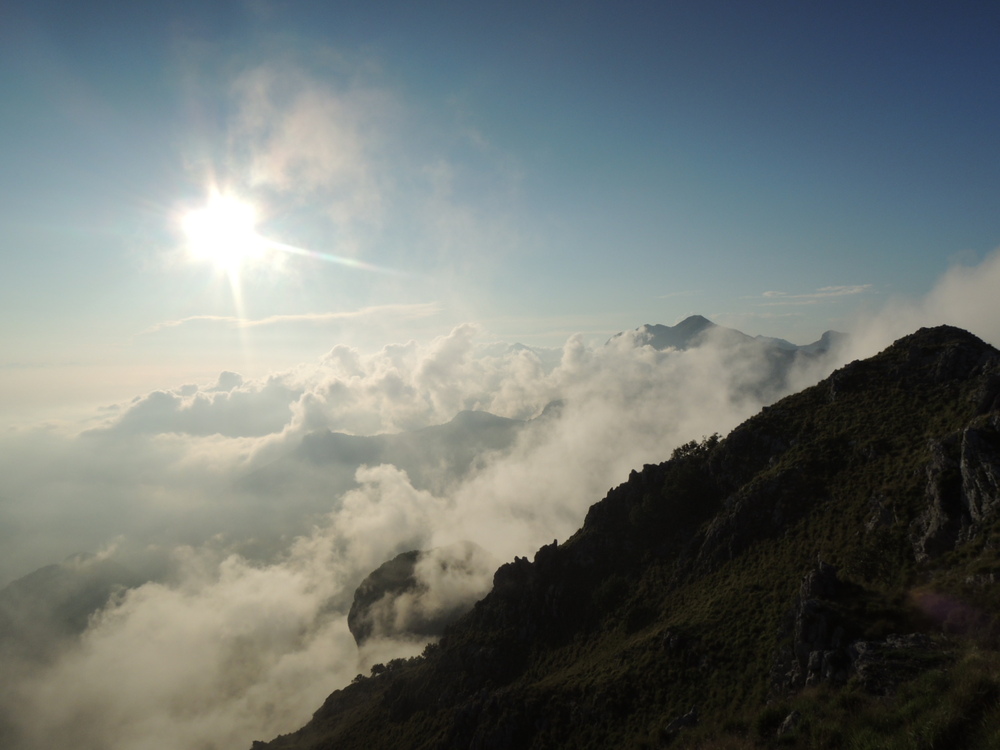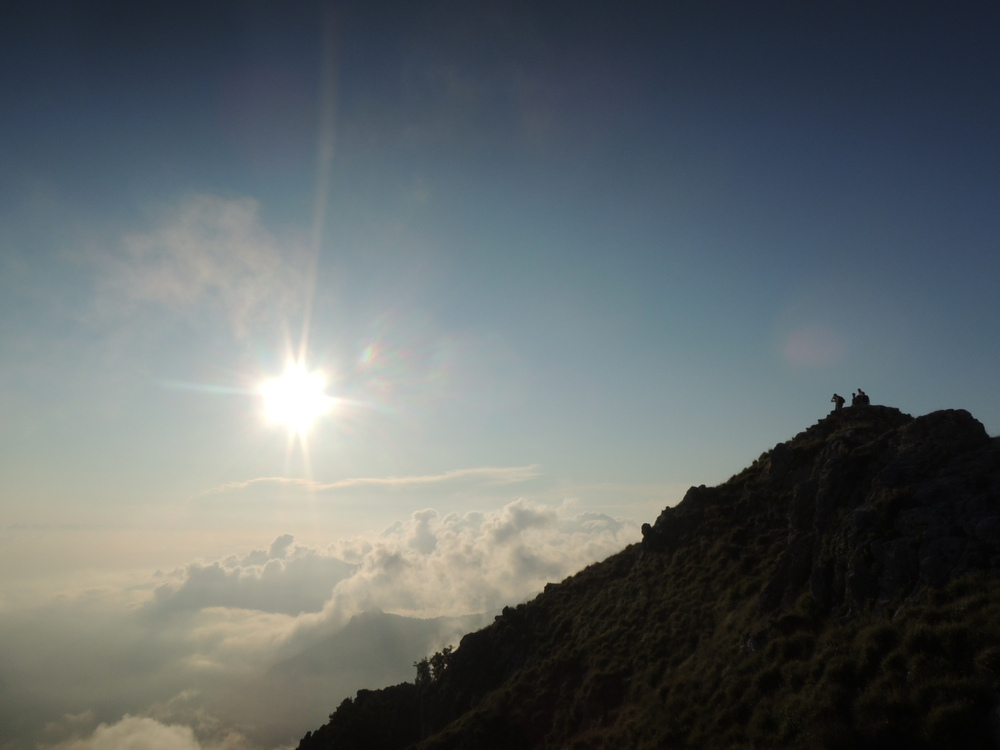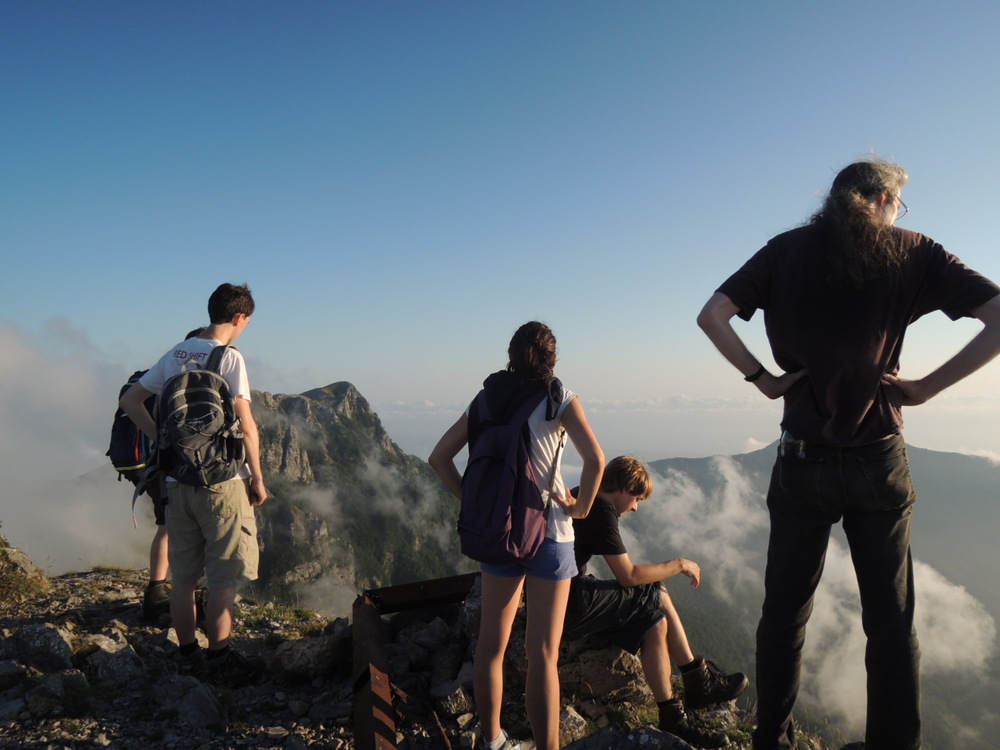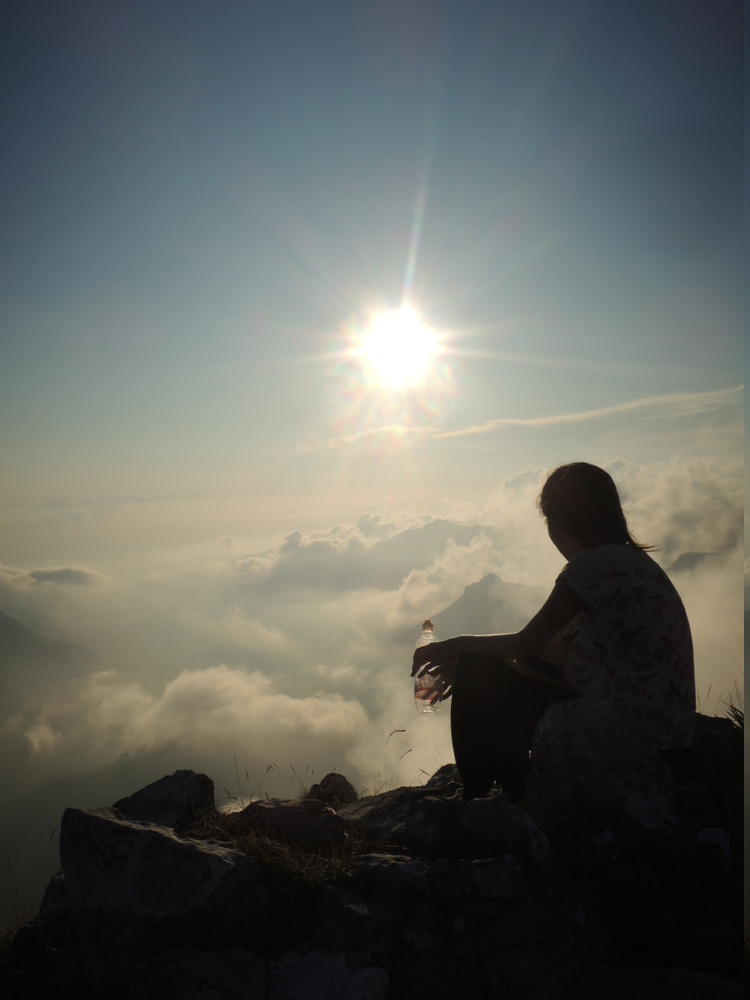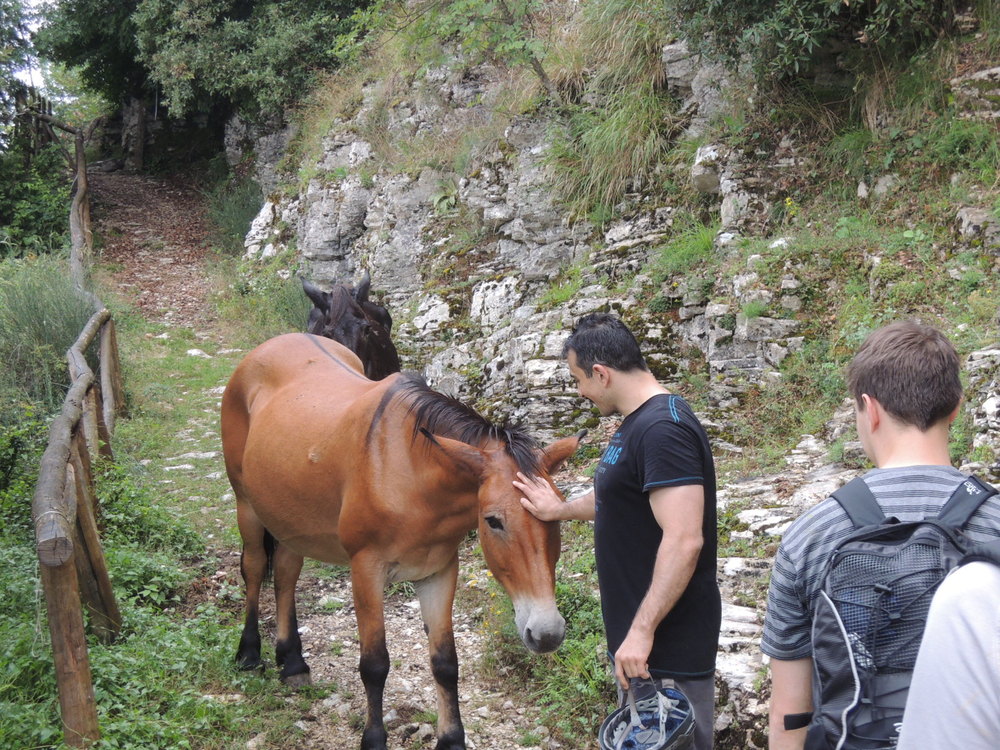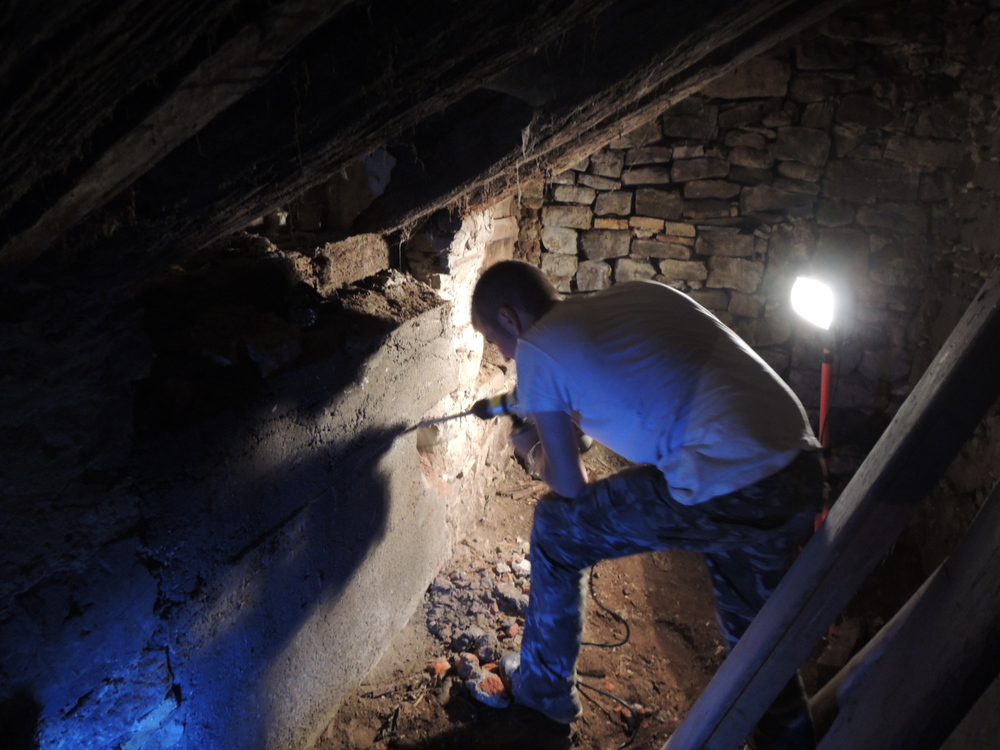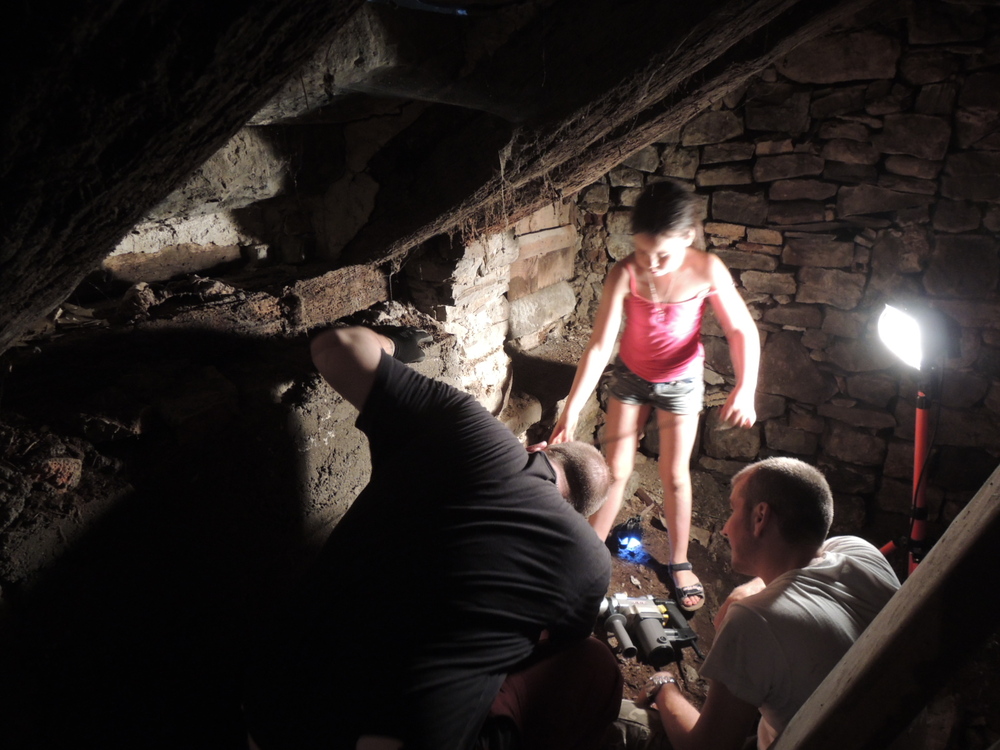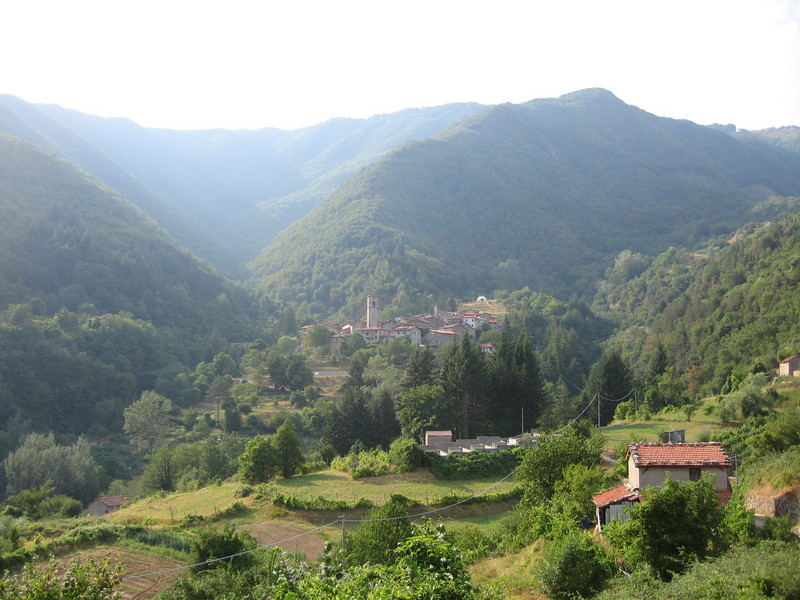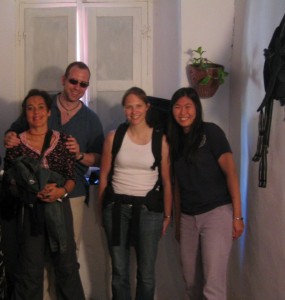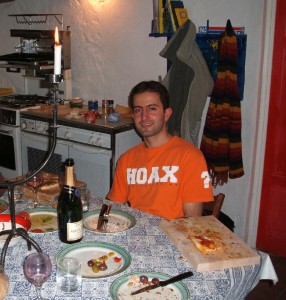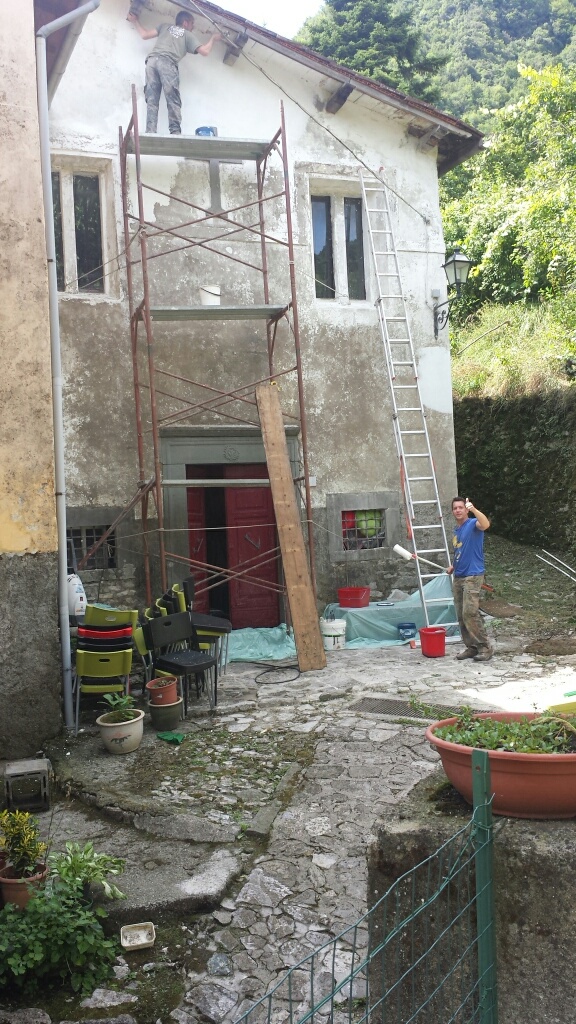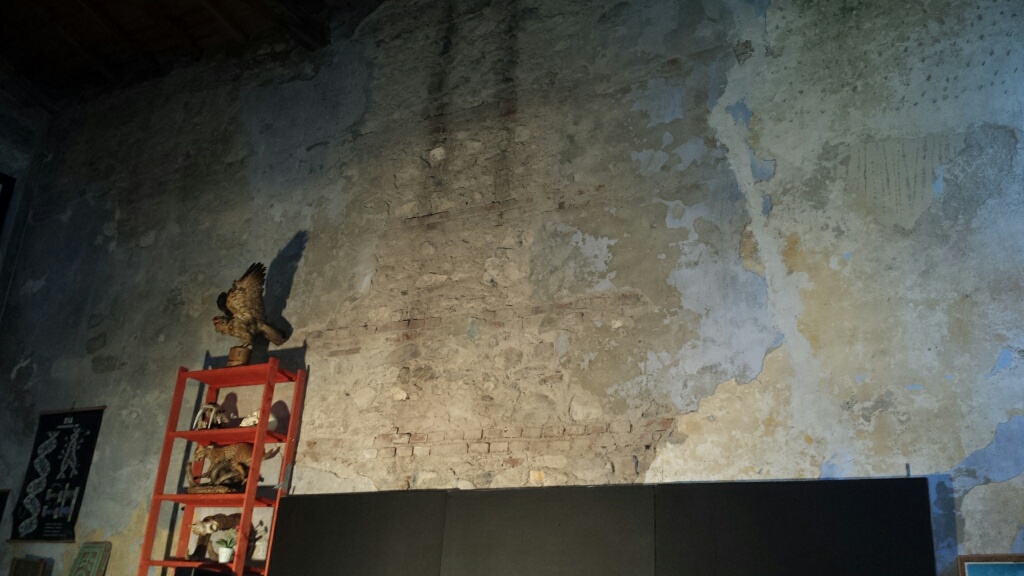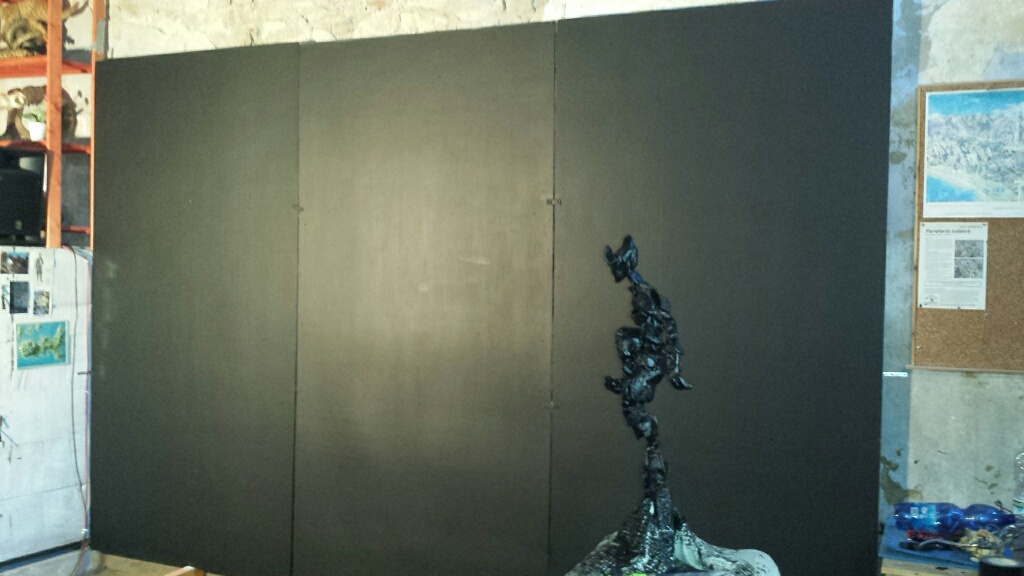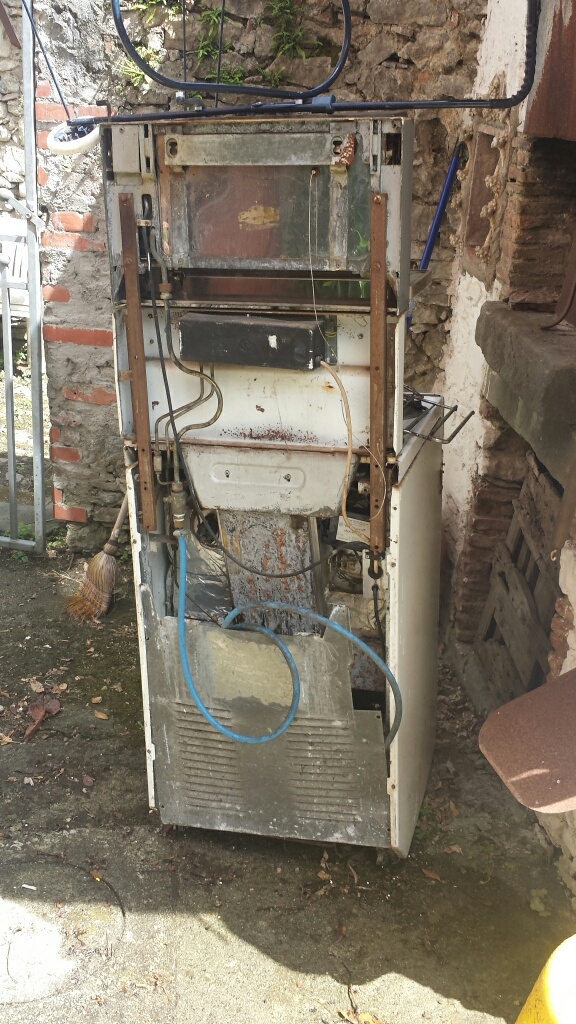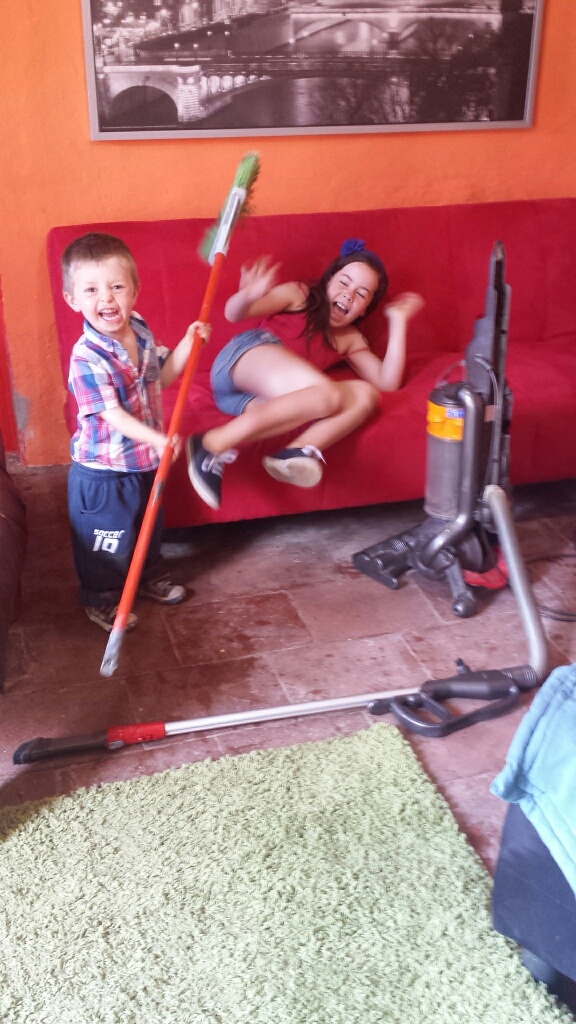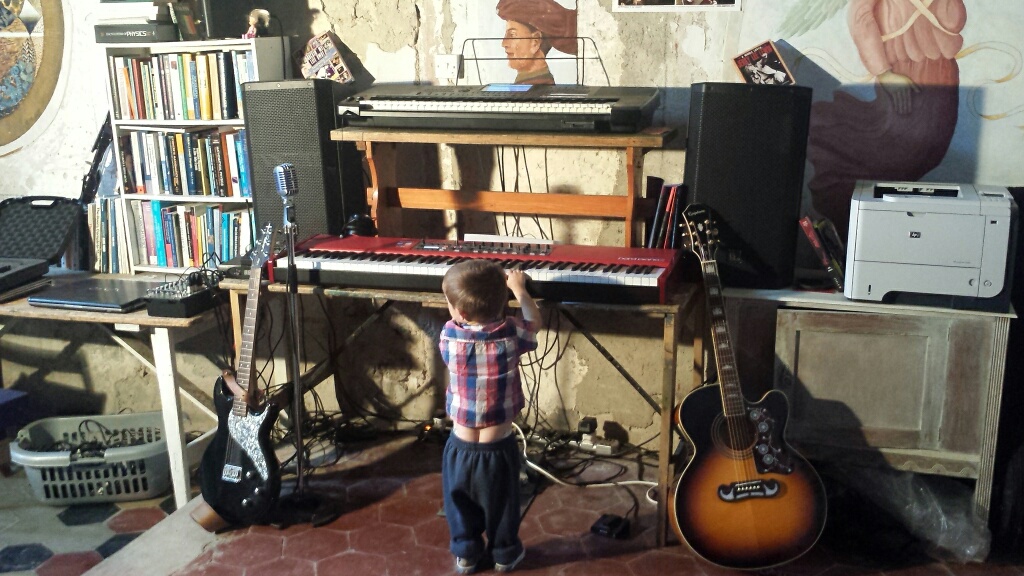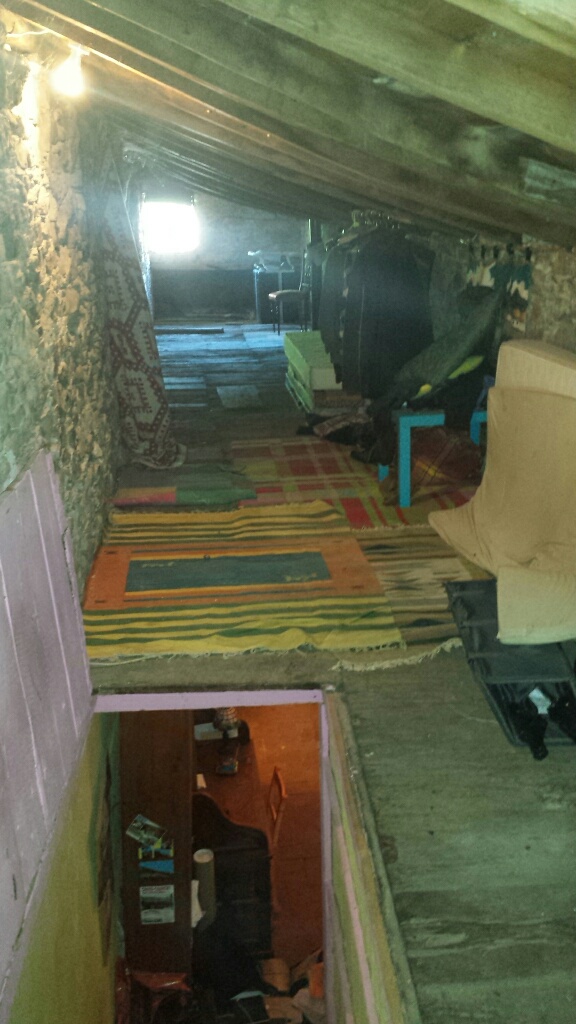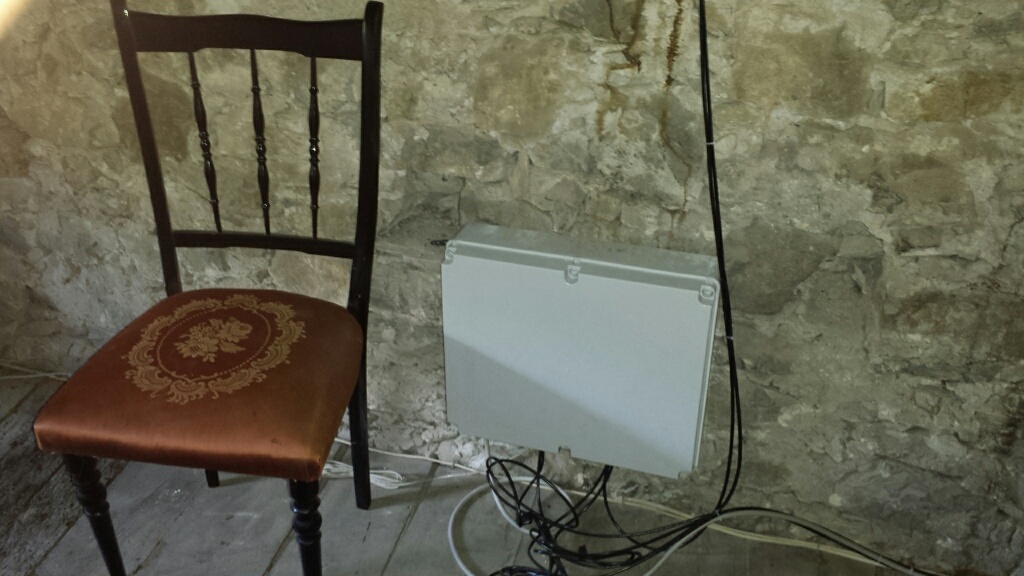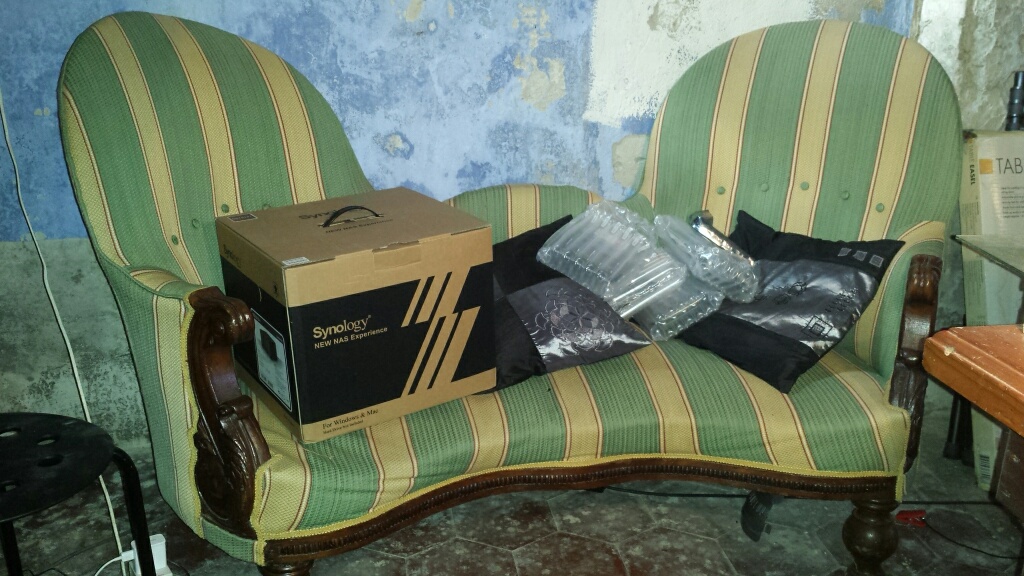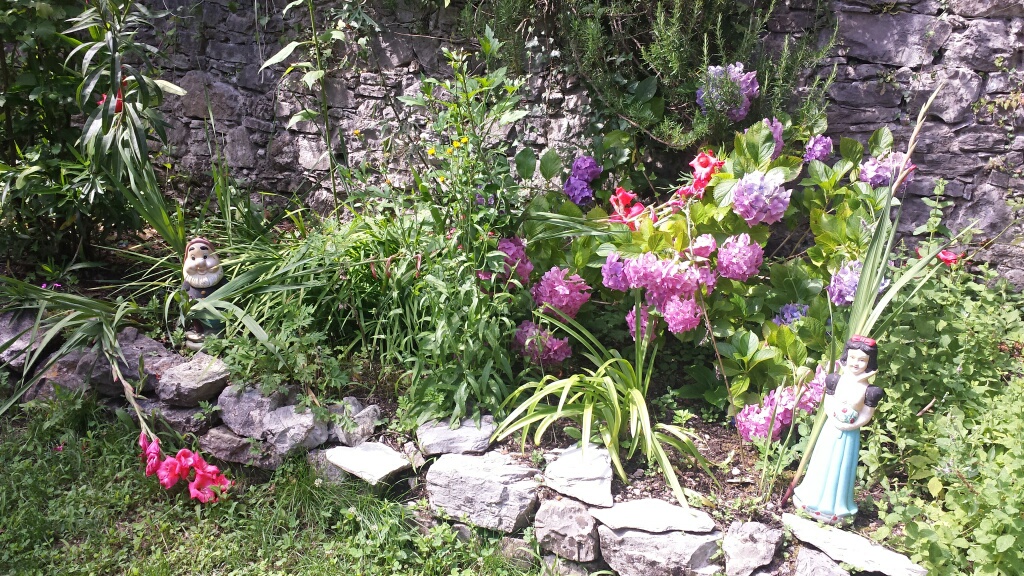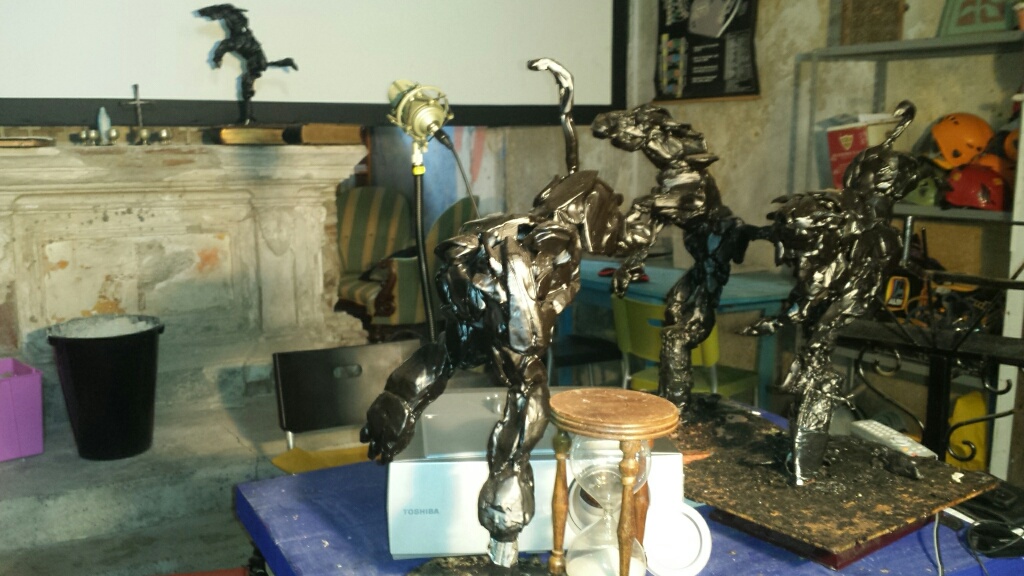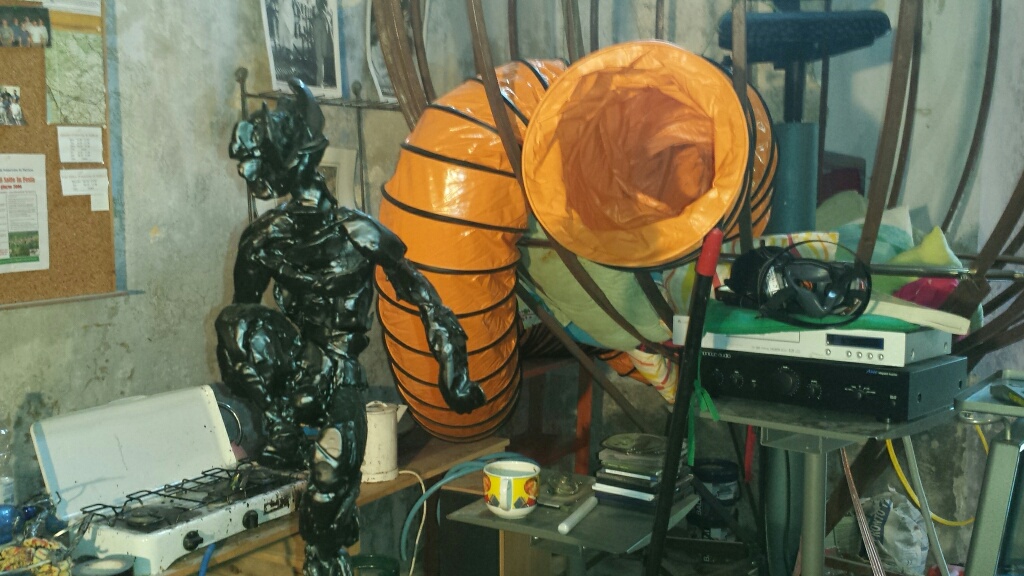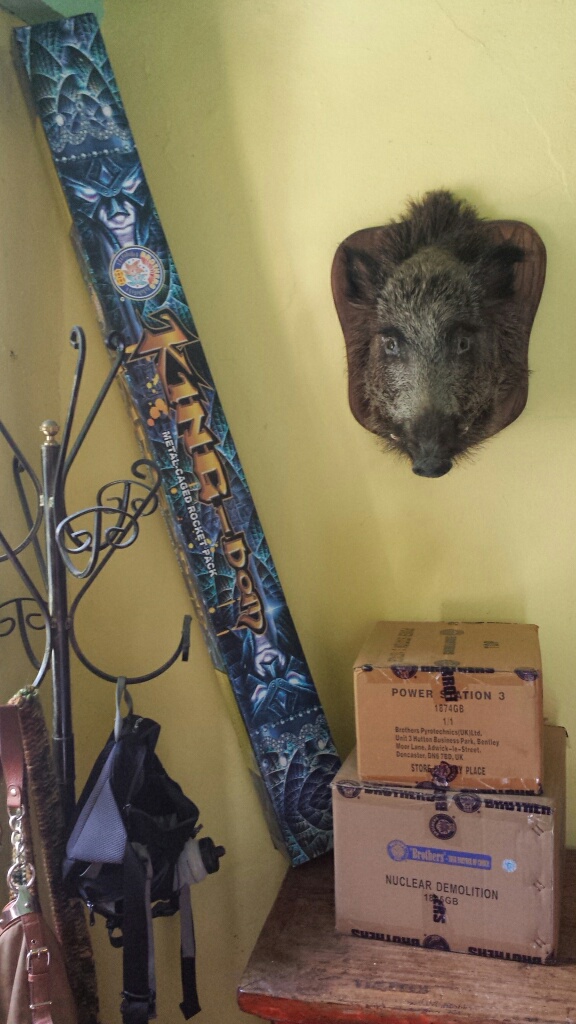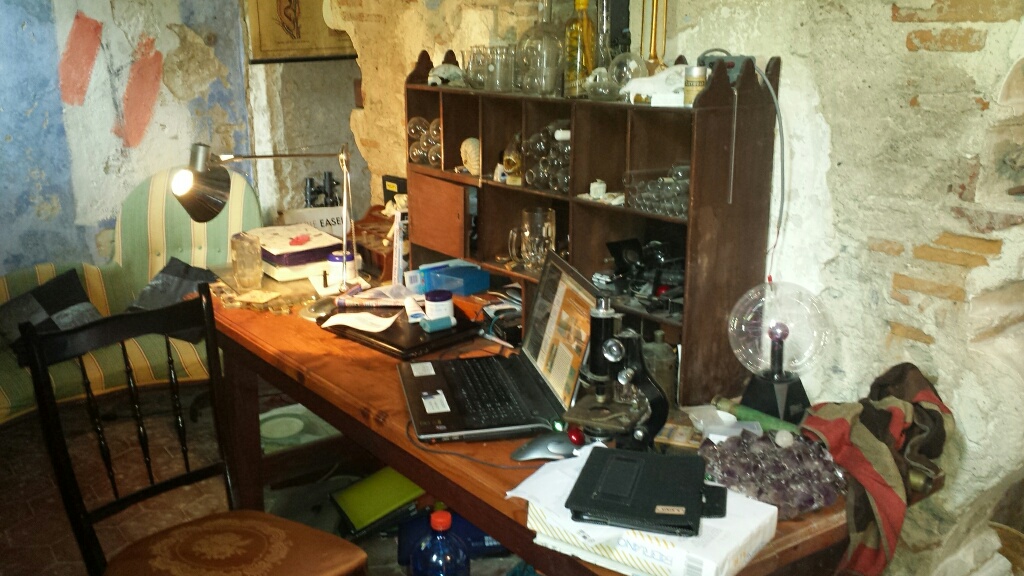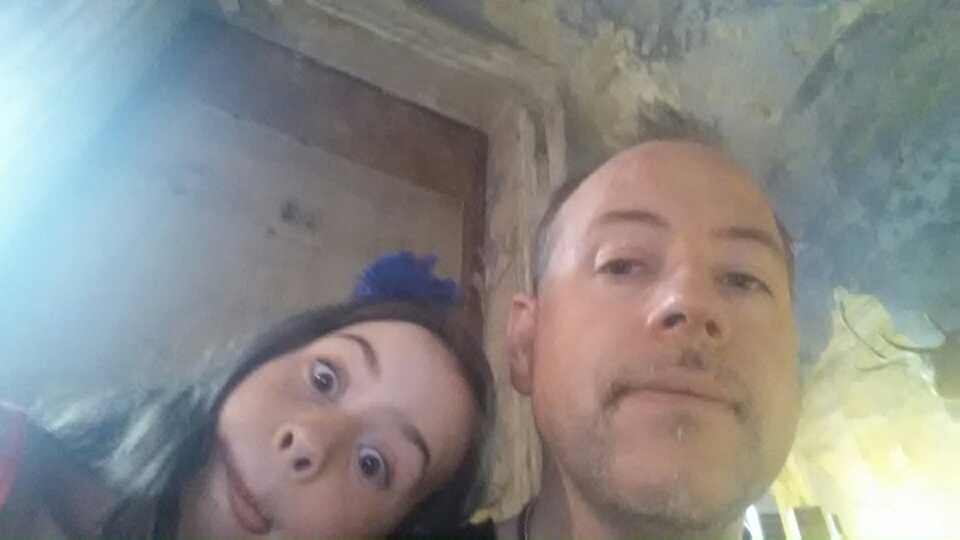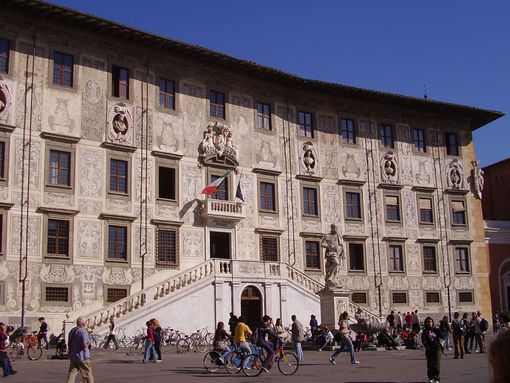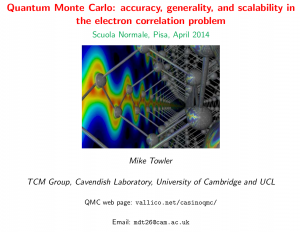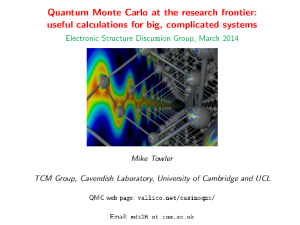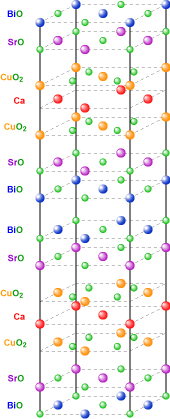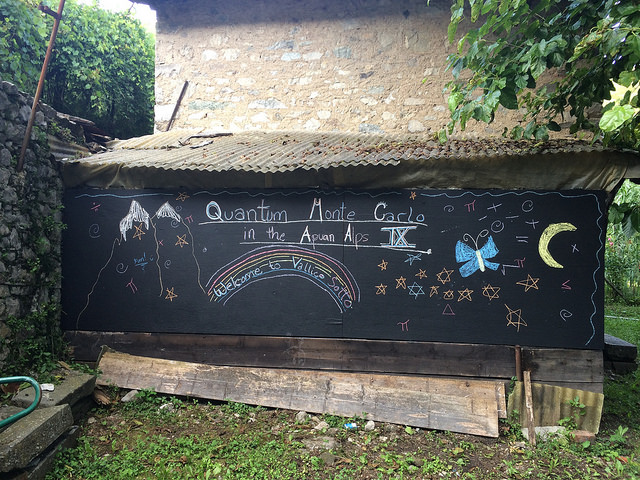
It was Daniela the barmaid who told me that the old people — though surely they weren’t so old that they would actually
remember — were saying that it was the worst summer weather in Tuscany since 1915. Well, round here you never know — they might be — and despite the rain, almost a hundred years later, forty-six people have gathered in Vallico Sotto to attend the ninth “Quantum Monte Carlo in the Apuan Alps” international workshop. From the 26th of July to the 2nd of August 2014 our resident physicists and chemists spent each morning listening to talks on quantum Monte Carlo and related computational electronic structure methods, followed by afternoons that were often full of mountain walking, caving, canyoning and other activities but — for pretty much the first time ever in history of events at TTI — were equally often cancelled because of the appalling weather.
A great deal of interesting science was presented and discussed at the meeting, and much of this is summarized in the scientific report further down this page. I think it’s now clear to most people that the quantum Monte Carlo method is continuing to grow in utility and importance, and for those with a big enough computer it self-evidently ought to be the method of choice for highly accurate benchmark quantum-mechanical calculations of molecules and materials — certainly those with more than a few atoms.
As described on the CASINOQMC blog some weeks ago, the monastery had undergone an extensive revamp for its 10th anniversary with a freshly painted exterior, sealed internal walls that don’t rain plaster on delicate electronics, and a vastly improved university-grade broadband wireless network extended to the whole site and nearby buildings with a dedicated Synology central file server (at one stage the Wifi was running over 150 connected devices). We also now have an outdoor ping-pong table, and our musical equipment was upgraded to the extent that the place can now be considered a live music venue. This was ably demonstrated by singer Ed Norris — hired for the opening night 10th Anniversary party — who moved many of the local people to tears with his renditions of ‘old Frank Sinatra/Tony Bennett-style songs’ [I’ve realized that I don’t know how to properly refer to this style of ‘Jazzy Pop Standard Lounge Swing Crooning’ which is often insultingly misfiled as ‘Easy Listening’ in record shops, but I think you know what I mean. It’s actually very cool, even if young people don’t generally like it or more likely have never heard of it.].
Anyway, away from their scientific activities, the participants mounted successful expeditions to Monte Procinto, Pania della Croce, the rock arch of Monte Forato, the cave of Cascaltendine, Monte Palodina and the flat top of Monte Penna, the beautiful city of Lucca, and the open-air swimming pool at Barga. These trips were followed by nice dinners at Alto Matanna, Da Sandra, Eremo di Calomini, Al Laghetto and the old restaurant at Vallico Sotto, specially opened yet again for the “Vallico Sotto against the World” football match. Tragically, the Rest of the World team shuddered under the second heaviest beating in history to the thrusting young lads of Vallico Sotto, despite not playing all that badly. Possibly they were suffocated by having a surfeit of players, in much the same way as King Henry 1st of England (though that was with lampreys, obviously).
Regular attendees may have heard me going on for years about the mysterious secret tunnel, closed as recently as the 1930s, which ran from somehere below the Doctor’s House in Vallico Sotto all the way up to the site of the former Fortress several hundred metres away at the top of the hill, and whose precise location has been lost to collective memory. After all the talk it was clear that it was time to find it or just shut up. Did we succeed..? Not during the conference, though Dario Bressanini did obtain a clue by posing as a tourist and talking to old ladies. And later? All will be revealed (possibly) in the next instalment of the ‘News from the Towler Institute‘ blog over at the Barga News site.
Quantum Monte Carlo in the Apuan Alps may return one day, but financial issues and the increasingly stupid organizational effort required means that summer 2015 will mark our first proper year off. Anyone wishing to use the place for their own meetings in which MDT doesn’t have to work so hard should contact him, preferably offering gifts (see p. 12 paragraph 5 of the current CASINO manual).
Documents
– Poster
– Original announcement
– Conference programme
List of participants
Dario Alfè, Sam Azadi, Giovanni Bachelet, Dario Bressanini, Shibing Chu, Ron Cohen, Gareth Conduit, Csaba Daday, Caterina De Franco, Andrea Droghetti, Neil Drummond, Edgar Engel, Matthew Foulkes, Leonardo Guidoni, Nic Harrison, Kenta Hongo, Blazej Jaworowski, Martin Korth, Jonathan Lloyd-Williams, Pierre-Francois Loos, Pablo López Ríos, Ryo Maezono, Fionn Malone, Mariapia Marchi, Bartomeu Monserrat-Sanchez, Elaheh Mostaani, Richard Needs, Carlo Pierleoni, Tom Poole, James Shepherd, Sandro Sorella, James Spencer, Alex Thom, Mike Towler, John Trail, Cyrus Umrigar, Tack Uyeda, Will Vigor, Ching-Ming Wei [CANCELLED: Stefano Baroni, Vincenzo Barone, Roberto Dovesi]
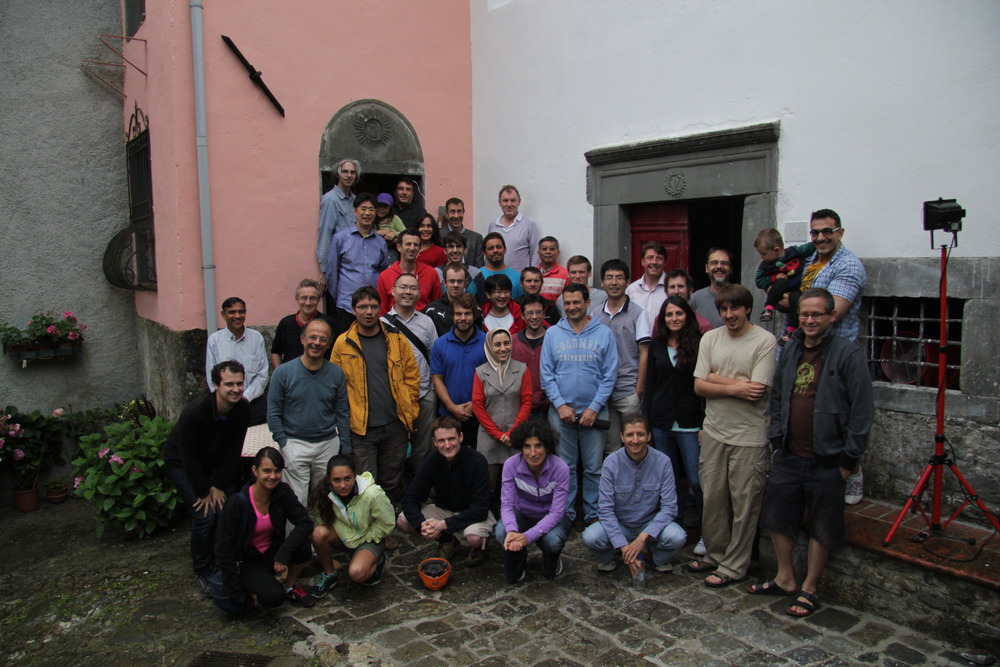 Photographs
Photographs
–
Ron Cohen
–
Gareth Conduit
–
Csaba Daday
–
Caterina de Franco
–
Pierre-Francois Loos
–
Mariapia Marchi
–
Mike Towler
–
Will Vigor
Music videos
– Mike Towler: Ed the Singer
– Pierre-Francois Loos: Italians are proud: riot at Laghetto
– Mike Towler: Bressanini and Bachelet: Folk Band
– Mike Towler: The dwindling audience of Jerry Lee Lewis
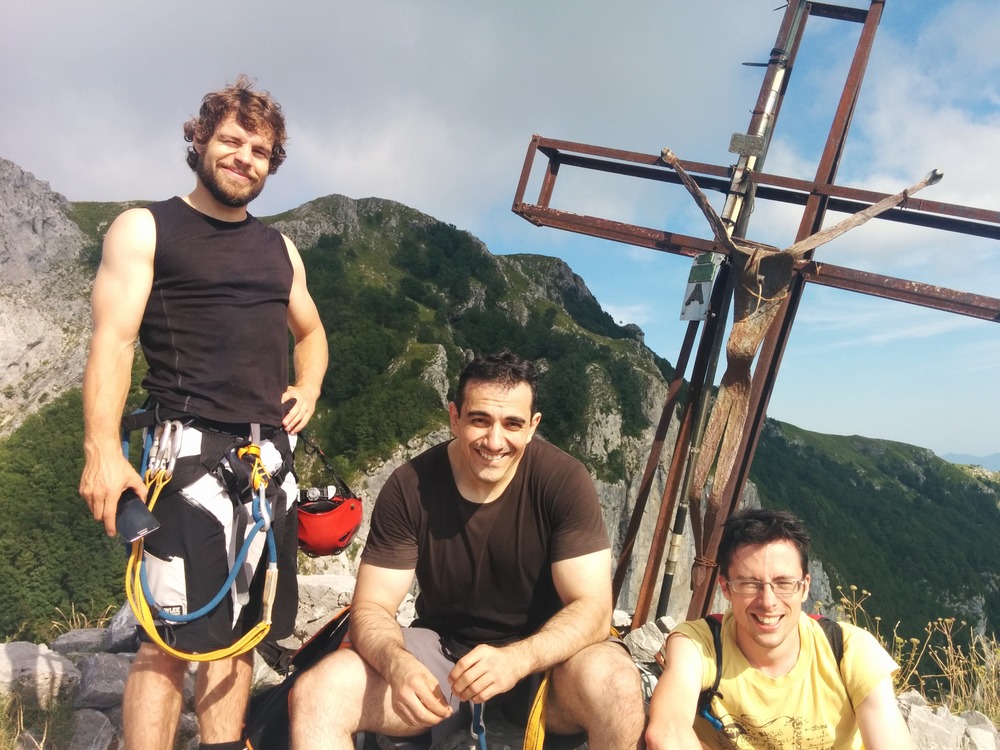
Talks presented
- Dario Alfè (d.alfe at ucl.ac.uk)
“Water clusters, ice, and bulk liquid: improving ab initio structure and energetics” [PDF]
- Ron Cohen (ronald.cohen at ucl.ac.uk)
“Quantum Monte Carlo simulations on silicate perovskite and other high pressure phases” [PDF]
- Gareth Conduit (gjc29 at cam.ac.uk)
“Pseudizing the Hamiltonian” [PDF]
- Csaba Daday (dadaycs at gmail.com)
“Wave function embedding methods and excited states: a guide to the perplexed” [PDF]
- Andrea Droghetti (drogheta at tcd.ie)
“Spin-crossover molecules: puzzling systems for electronic structure methods” [PDF]
- Neil Drummond (n.drummond at lancaster.ac.uk)
“Electronic and vibrational properties of monolayer hexagonal indium chalcogenides” [PDF]
- Edgar Engel (eae32 at cam.ac.uk)
“Anharmonic nuclear motion and the relative stability of hexagonal and cubic ice” [PDF]
- Leonardo Guidoni (l.guidoni at gmail.com)
“Geometries and properties of (bio)molecules by quantum Monte Carlo” [PDF]
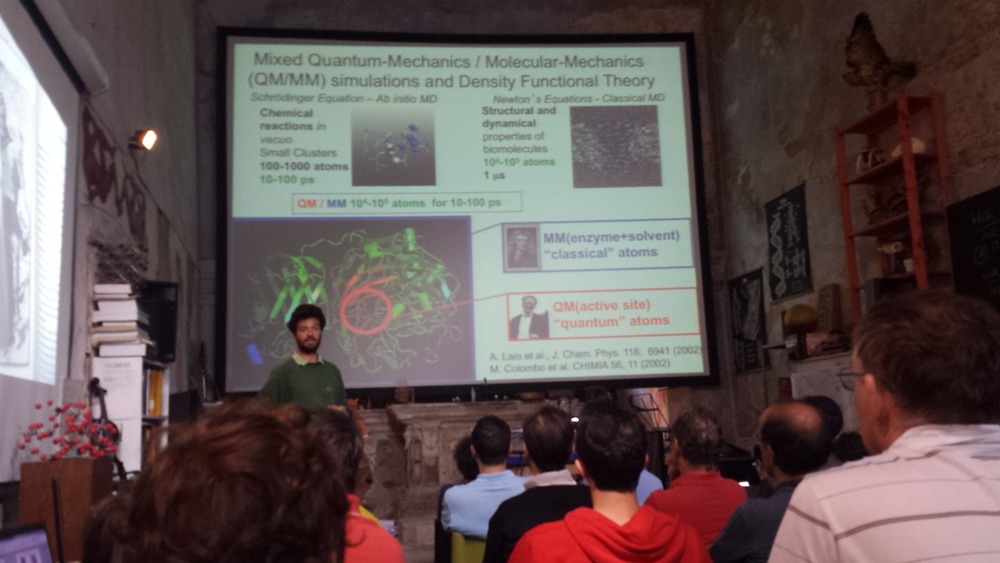
- Nic Harrison (nicholas.harrison at imperial.ac.uk)
“Describing strong interactions – some outstanding problems” [PDF]
- Kenta Hongo (kenta_hongo at mac.com)
“QMC applications to noncovalent interactions in cyclohexasilane dimers” [PDF]
- Martin Korth (martin.korth at uni-ulm.de)
“On the hunt for molecular organic battery materials” [PDF]
- Jonathan Lloyd-Williams (jhl50 at cam.ac.uk)
“DFT and QMC calculations of solid molecular hydrogen” [PDF]
- Pierre-Francois Loos (loos at rsc.anu.edu.au)
“Chemistry in a 1D world” [PDF]
- Pablo López Ríos (pl275 at cam.ac.uk)
“Multideterminant compression algorithm for quantum Monte Carlo” [PDF]
- Ryo Maezono (rmaezono at mac.com)
“Embedded atom into jellium sphere” [PDF]
- Fionn Malone (f.malone13 at imperial.ac.uk)
“Parallel strategies for FCIQMC” [PDF]
- Mariapia Marchi (marchi at esteco.com)
“Using modeFRONTIER to automate DFT and QMC calculations: application to liquid hydrogen” [PDF]
- Bartomeu Monserrat Sanchez (bm418 at cam.ac.uk)
“An overview of vibrations in solids” [PDF]
- Elaheh Mostaani (emostaani at gmail.com)
“Binding energy of bilayer graphene (updated) and electronic properties of oligoynes” [PDF]
- Richard Needs (rn11 at cam.ac.uk)
“Xenon oxides under pressure” [PDF]
- Carlo Pierleoni (carlo.pierleoni at aquila.infn.it)
“Liquid-liquid phase transition in high pressure hydrogen: new predictions from CEIMC and comparison with DFT” [PDF]
- Tom Poole (thomas.poole10 at imperial.ac.uk)
“Algorithmic differentiation of diffusion Monte Carlo” [PDF] [NOT YET AVAILABLE]
- Sandro Sorella (sorella at sissa.it)
“Ab initio simulation of liquid water by quantum Monte Carlo” [PDF]
- James Spencer (j.spencer at imperial.ac.uk)
“An overview of the HANDE QMC project” [PDF]
- Alex Thom (ajwt3 at cam.ac.uk)
“FCIQMC and finite electron gases” [PDF]
- Mike Towler (mdt26 at cam.ac.uk)
“High-throughput QMC” [PDF]
(Missing 5 slides near the end due to accidental file deletion – to be reconstructed.)
- John Trail (jrt32 at cam.ac.uk)
“Pseudopotentials for correlated electron systems” [PDF]
- Cyrus Umrigar (cyrusumrigar at gmail.com)
“Semistochastic quantum Monte Carlo: a hybrid of exact diagonalization and quantum Monte Carlo methods” [PDF]
- Tack Uyeda (tueeeda at jaist.ac.jp)
“Estimation of exchange interaction of SrMnO3 by QMC” [PDF] [NOT AVAILABLE]
- William Vigor (w.vigor11 at imperial.ac.uk)
“Unloading the dice: minimising biases in full configuration interaction quantum Monte Carlo” [PDF]
- Ching-Ming Wei (cmw at phys.sinica.edu.tw)
“Binding energy of 2D materials using QMC” [PDF]
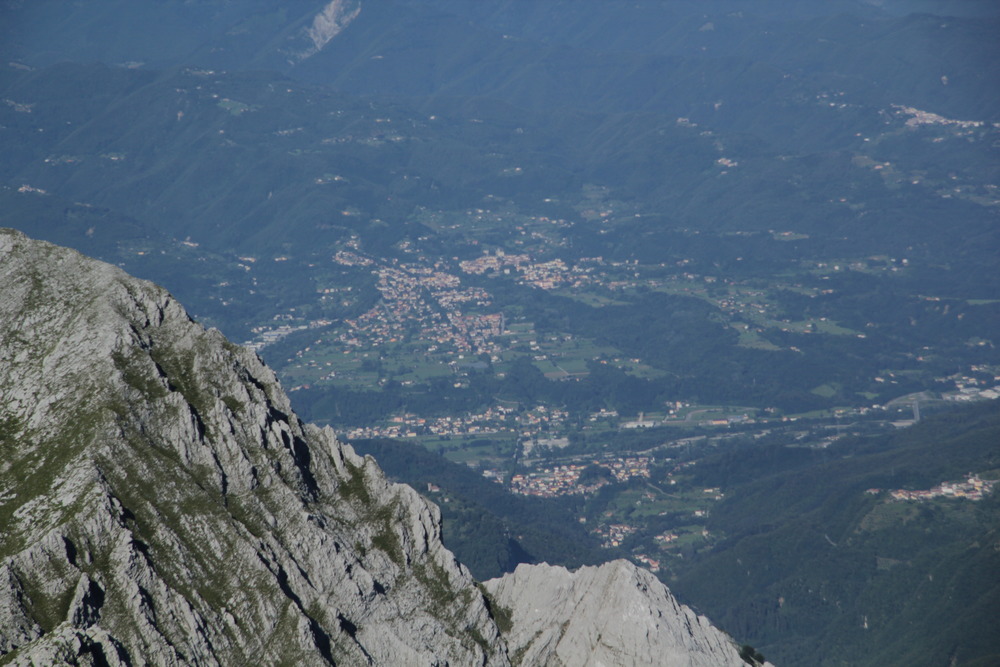
Scientific reportParticipants at the conference gave presentations on a very wide range of topics which I shall attempt to summarize below. I have divided them very roughly into two sections: (1) theoretical, algorithmic, and computational developments (which of course may involve interesting applications), and (2) applications. Some of the talks could conceivably fit in either of those categories; in such cases I have arbitrarily chosen one.
TheoryJohn Trail gave a very interesting report on his continuing efforts with Richard Needs to develop ‘correlated electron pseudopotentials’ more appropriate for use in explicitly many-body methods such as QMC than the one-electron Dirac-Fock/Hartree-Fock/DFT pseudopotentials that have traditionally been used. He showed that many of the difficulties associated with doing this can be alleviated by generating the pseudopotentials in very ionized atomic states, which are then very transferable to neutral states. Explicitly-correlated QMC results using these pseudopotentials were shown to be significantly more accurate than with Hartree-Fock pseudopotentials for a wide range of molecules and also for more difficult cases such as strongly-correlated and complex transition metal systems.
Multi-determinant expansions are a tool often used in quantum chemistry to construct very accurate wave functions. These can be used directly as trial wave function input to a QMC program but lengthy expansions of this nature can be very slow to evaluate. Pablo López Ríos presented a compression method for significantly reducing the computational cost of such expansions, whilst maintaining the desirable properties of leaving the existing evaluation algorithm unchanged and the original expansion coefficients optimizable. His implementation in the CASINO program showed compression ratios of between 2 and 25 in tests, and these factors translated more or less directly into an overall speedup of the calculation.
Csaba Daday presented work done in collaboration with the group of Claudia Filippi on using an embedding method to combine different levels of theory to describe ground and excited states of biomolecules. In particular, he showed one way of describing the ‘important’ parts of molecules with high-level wave function theory (perturbation theory, coupled cluster, or even DMC) while treating the rest of the system at the DFT level. Unfortunately, while this scheme seems to work well for small solvated molecules, the excitation energies obtained for green fluorescent protein were severely blue-shifted compared to experimental values. His conclusion was that classical embedding (point charges and induced dipoles) is the way to go until better functionals become available for DFT embedding. Clearly significant development work remains to be done.
In his presentation Bartomeu Monserrat-Sanchez showed how to include the effects of atomic vibrations in the calculation of total energies, electronic band gaps, and NMR parameters in first principles calculations. He demonstrated, for example, that static DMC and GW band gaps of diamond are in error by about 0.5 eV due to the neglect of electron-phonon coupling.
Prof. Sorella outlined his recently developed method for performing ab initio molecular dynamics simulations with quantum Monte Carlo. In this technique, ionic forces are computed using highly accurate variational wave functions containing several parameters that are fully optimized on the fly. He showed recent results obtained for hydrogen at high pressure and for liquid water at ambient conditions. Though preliminary the results were clearly very interesting and promising for future applications.
Pierre-Francois Loos of the National University of Australia gave an unusual but very interesting presentation showing that finite-size uniform electron gases can be used to create a generalised version of the local-density approximation. He observed that this new functional can be applied to one-dimensional inhomogeneous systems and that it yields accurate estimates of the correlation energy. He also discussed atoms and molecules in one dimension and demonstrated that, in distinct contrast to our world, one-dimensional atoms are bound by one-electron bonds.
Gareth Conduit’s talk was entitled “Pseudizing the Hamiltonian“. He began by describing the contact interaction often used in modelling ultracold atomic gases, and how it leads to pathological behavior driven by the divergence of the many-body wave function when two particles coalesce. He then proposed a family of smooth pseudopotentials which reproduce the scattering phase shifts of the contact interaction, resulting in significant improvements in efficiency when used in numerical calculations. Finally, he showed how to extend this formalism to generate a pseudopotential for the Coulomb electron-electron interaction in such a way that calculations can be accelerated by an order of magnitude.
Mike Towler’s presentation focussed on ‘high-throughput QMC’ – motivated by the remark made by Tim Mueller at last year’s meeting: “By 2016-ish, we should be able to calculate QMC energies for every known inorganic material on a single supercomputer in about a week (roughly).” Towler showed how it was possible for QMC calculations to ‘monitor themselves’ so that (a) they know when they have equilibrated and it is possible to begin accumulating statistics, (b) they know when they have achieved a desired target for the statistical error bar – which may be set in input – and then automatically stop, and (c) they know when a desired target error bar is ‘unreasonable’ and cannot be attained with a reasonable amount of computation. This can largely be done in a statistically valid way using a ‘distribution-free’ technique which does not rely on the validity of the central limit theorem. It is to be hoped that techniques such as these can help to greatly improve the rate at which calculations of large datasets can be done.
Full configuration interaction QMC (FCIQMC) and related methods such as semi-stochastic QMC have received a substantial amount of attention in recent years, and we were treated to six separate talks on this topic. These techniques arguably have a non-traditional focus compared to regular QMC calculations since they attempt to obtain the full configuration interaction result, i.e., the exact result for a finite basis set, with reduced but still non-polynomial scaling. The utility of such results can typically be seen in the benchmarking of other finite basis methods for small molecules and dimers, but there have also been successes in applying FCIQMC directly to solids such as nickel oxide chains. One can argue that FCIQMC has, in some sense, created a bridge between the usual QMC community and the quantum chemistry community and demonstrated the benefits of a stochastic approach to users of wave function-based methods. Amongst other developments, this has resulted in a stochastic version of coupled cluster theory developed by Alex Thom and collaborators.
Such developments are of course greatly assisted by the availability of high-quality standard software and a particularly promising new open-source code is the ‘highly-accurate N-determinant’ project : HANDE. We heard five talks given by the developmental team of HANDE, which is apparently nearing its public release. Will Vigor of Imperial College, London and James Shepherd of Rice University, focussed on attempts to understand the algorithmic detail of FCIQMC. They reported on errors related to the stochastic algorithm and systematic issues arising from the sign problem. Fionn Malone, also of Imperial College showed how FCIQMC can be parallelized more efficiently using non-blocking asynchronous communication (apparently motivated by Towler’s similar developments in CASINO from several years earlier). Alex Thom of Cambridge University discussed applications of FCIQMC and its coupled cluster equivalent to finite electron gas systems. James Spencer from Imperial gave the final talk as the lead developer in HANDE, and summed up how this work and many others besides had been made possible by access to this new piece of software.
A different but related technique known as semi-stochastic QMC was reported by Prof. Cyrus Umrigar of Cornell University. He presented developments that potentially offer routine efficiency gains of orders of magnitude over FCIQMC, while apparently not compromising on the quality of the resulting full CI energies.
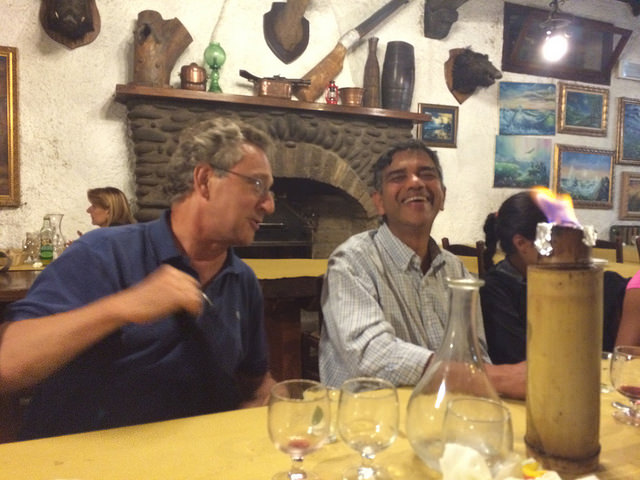
It seems clear that this community has much to do to make FCIQMC etc. routinely useful such that a quantum chemist might consider using it instead of their traditional techniques (it’s bad enough trying to get them to use a non-Gaussian basis set, after all). The exponential scaling with system size remains a serious issue (the main advantage of DMC, for example, is the favourable N
3 scaling
combined with the high accuracy; of course many techniques exist which can do just high accuracy). Clearly much can be gained from observing similar problems that have been solved in more traditional QMC techniques, and this was reflected in the many and varied questions put to the speakers and the lively discussions that followed both in the session and outside of them.
ApplicationsJonathan Lloyd-Williams presented the results of a combined DFT and DMC study of the phase diagram of solid hydrogen at pressures from 100 to 400 GPa. He and his collaborators have performed highly accurate DMC calculations of the static lattice energies of several candidate structures for the various experimentally observed phases of solid molecular hydrogen. By combining the DMC energies with anharmonic vibrational free energies — calculated using the method described in the talk by Monserrat-Sanchez — they found a phase transition between two of the candidate structures at pressures and temperatures in good agreement with those experimentally observed for the phase III/IV transition in solid hydrogen.
Prof. Alfè began by demonstrating the serious deficiencies in the DFT description of water. By decomposing the energy of water systems into a sum of one-body, two-body and many-body terms, and by providing energy benchmarks with CCSD(T) and QMC, he showed that different functionals have different errors in these terms. For example, BLYP has serious two-body errors but relatively small many-body errors. PBE has fairly small two-body errors but larger many-body errors. Alfè then showed that BLYP two-body errors can be effectively eliminated using GAP technology, and the resulting BLYP+GAP potential energy functional provides a good radial distribution function for water at ambient conditions.
Prof. Guidoni gave a very colourful and wide-ranging talk entitled ‘Geometries and properties of biomolecules by quantum Monte Carlo‘, showing calculations of various molecules up to and including models for large biological chromophores. He demonstrated – amongst other things – accurate QMC energies for ground and excited states, geometries, polarizabilities, and harmonic and ananharmonic frequencies. He also showed that geometry optimizations involving more than 100 atoms are now feasible, and that the so-called JAGP wave function (‘Jastrow antisymmetrized geminal power’) – a highly-accurate variational wave function based on Pauling’s ‘resonating valence bonds’ idea – is sufficiently flexible to do useful science at the VMC level rather than the more expensive DMC.
Prof. Cohen showed some applications of DFT, QMC and DFT-DMFT to silicate perovskite, cubic boron nitride, iron monoxide, and a number of other materials at high pressures.
Elaheh Mostaani from the University of Lancaster gave a talk about DMC results for the binding energy of bilayer graphene, demonstrating once more how you can get any answer you like with density functional theory when dealing with van der Waals or other weak interactions – with the sad exception of the correct one [Mike ducks to avoid missiles..]. She also showed preliminary results for a DMC study of the ground- and excited-state electronic properties of oligoynes (end-capped linear carbon chains with alternating single and triple bonds).
Edgar Engel presented DFT PBE calculations of the anharmonic quantum vibrational energies for hexagonal and cubic ice, showing that the thermodynamic stability of hexagonal ice with respect to cubic ice has its origin in the smaller anharmonicity of the nuclear vibrations. Using the displacement patterns of the corresponding high-energy hydrogen vibrational modes, this can be traced back to structural differences between the hexagonal and cubic forms, or more specifically, to the fact that hexagonal ice contains both boat- and chair-form hexamers of H2O molecules whilst cubic ice contains only chair-form hexamers.
As has become traditional, Prof. Needs gave a talk about ab initio random structure searching within DFT, this time with the aim of identifying stable stoichiometries and structures of xenon oxides under pressure.
Kenta Hongo from Japan spoke about noncovalent interactions in cyclohexasilane dimers (which are potentially important in ‘liquid silicon inks’ used as a source material for Si thin films). He compared and constrasted results for calculations done with various different DFT functionals along with MP2, CCSD(T), and DMC methods. The latter two, as they should, showed good agreement. He also showed preliminary results for a DMC study of metallic hydrogen at high pressure.
Martin Korth presented research on molecular organic battery materials with a focus on liquid electrolyte solvents. He used a variety of computational methods from wave function theory to strongly empirical quantitative structure-property relationships with the aim of screening for advantageous compounds. He was able to demonstrate that such an integrated approach is already helping experimentalists to design better electrochemical energy storage devices, and he also gave some insights into the complexity of an accurate computational treatment of electrochemical processes at the atomic scale.
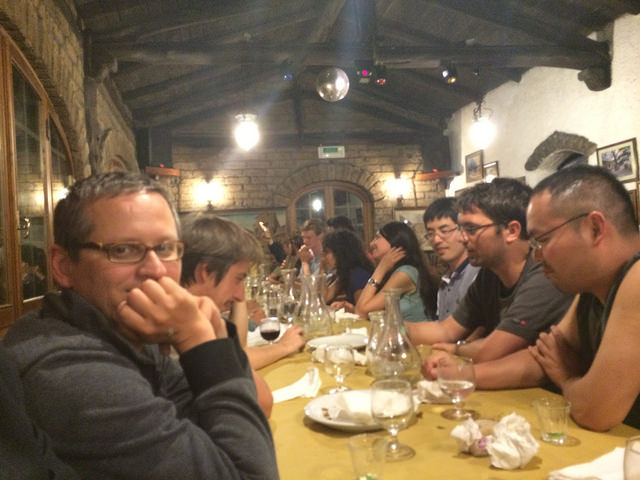
Neil Drummond gave a talk in which he described density functional theory calculations of the electronic band structures, cohesive energies, phonon dispersions and optical absorption spectra of a new class of two-dimensional crystals: In
2X
2, where X is S, Se or Te. Two crystalline phases (α and β) of monolayers of hexagonal In
2X
2 were identified, and it was shown that they are characterized by different sets of Raman-active phonon modes. Drummond’s calculations showed that these materials are indirect-band-gap semiconductors with a sombrero-shaped dispersion of holes near the valence-band edge. The latter feature results in a Lifshitz transition (a change in the Fermi-surface topology of hole-doped In
2X
2) at experimentally accessible hole concentrations. Quantum Monte Carlo calculations are clearly required to describe the electronic structure of these materials with quantitative accuracy.
Prof. Nic Harrison gave an interesting talk on a number of different problems. First of all he investigated whether it was possible to perform accurate compuations of the potential energy surface for the scattering of He atoms off an MgO (100) surface. He showed that it was possible to get close to the exact curve but only with considerable effort (involving doing MP2 calculations of the periodic system with the CRYSCOR code, with coupled-cluster corrections computed using a finite molecule). He also presented a very nice discussion comparing and contrasting the effects of breaking the symmetry in a linear polyacetylene chain using both dimerization (Peierls distortion) and spin-polarization.
Mariapia Marchi showed how the workflow of computations involving both DFT and QMC can be optimized using the commercial software modeFRONTIER developed at the ESTECO S.p.A. company located in Trieste. The modeFRONTIER (mF) code is described as ‘an integration platform for multi-objective and multi-disciplinary optimisation, with an unlimited range of applications, though mainly used in engineering design optimisation‘. In her talk, Marchi focussed on a system of sixteen hydrogen atoms in the molecular liquid phase. DFT runs were used to fill in the Slater-determinant part of the wave function, while one-, two- and three-body terms in the Jastrow factor were optimised with VMC. This was followed by a molecular dynamics step using a second-order Langevin dynamics to sample the ionic configurations within the Born-Oppenheimer approximation. For each new atomic position, the determinant part was filled with new orbitals and the Jastrow factor re-optimised. DFT and VMC energies can be monitored on the fly through mF’s graphical user interface during the run. Although results were shown only for a simple test system, it is clear that this sort of thing can be very useful, for example, in investigating the properties and phase diagram of larger systems in order to avoid finite-size effects.
Andrea Droghetti reported extensive calculations assessing the performances of DMC for ‘spin crossover’ molecules containing Fe(II) ions. Looking at the spin crossover transition he showed that, independently of the choice of the trial wave function, DMC gave an energy difference between the high spin (spin=2) and low spin (spin=0) states which was almost an order of magnitude larger than that computed with state-of-art CASPT. As he pointed out, the quantum chemists normally tell us to trust CASPT2 as a reference so this is a little puzzling, to say the least. Of course we expect DMC to be even better, since with CASPT2 the short-range correlations are treated only perturbatively in contrast to the essentially exact QMC treatment. Andrea says ‘this calls for new studies aimed at unrevealing the shortcomings of both DMC and CASPT for transition metal complexes, which confirm themselves as very challenging systems even for the most advanced electronic structure methods available’.
Prof. Ching-Ming Wei from Taiwan presented various materials simulation applications of QMC including CO adsorption on late transition metal (111) surfaces and the binding energies of 2D layers such as graphene, BN films, and silicene. Though limited computer resources meant that there some issues with DMC error bar convergence he showed a large number of interesting results in systems where DFT is known to fail.
Carlo Pierleoni gave a presentation in which he outlined the established Coupled Electron Ion Monte Carlo (CEIMC) method, and showed an application to the liquid-liquid phase transition in high pressure hydrogen. The region of the phase diagram where molecular hydrogen — stable at low pressure and temperature — transforms into a mono-atomic or plasma state with increasing pressure and/or temperature is both interesting and challenging, in particular since molecular dissociation under pressure is also accompanied by a metal-insulator transition. Traditional QMC methods are largely used to study ground states and miss the important temperature dependence, and the usual Path Integral MC method for fermions is limited to the temperature range above 10-15K. CEIMC is a QMC method, based on the Born-Oppenheimer approximation, in which nuclear degrees of freedom, either classical or quantum, are sampled by standard MC methods, while the electronic energy is obtained by highly accurate ground state QMC method for the electrons. The use of Born-Oppenheimer means CEIMC is capable of investigating the temperature range below which electronic thermal excitation can be safely neglected in the system, and allows one to apply QMC methods to high pressure hydrogen in the most interesting region of the phase diagram where molecular dissociation and metalization under pressure occur. Prof. Pierleoni showed the results of calculations of the molecular dissociation under pressure both with CEIMC and Born-Oppenheimer MD employing several XC functionals, both for classical and quantum nuclei. All the theories (except PBE with quantum nuclei) led to the same qualitative picture of the existence of a weakly first-order liquid-liquid phase transition below some temperature. The precise location of the transition line and of the critical point strongly depended on the theory with the CEIMC line lying in between the GGA-PBE line (at lower pressure) and the vdW-DF2 line (at higher pressure). Note that the pressure difference with different DFT functionals was up to several hundred GPa. The quantitative prediction for the location of the transition line depended crucially on the relative accuracy with which a specific theory can treat both molecular and atomic (or plasma) states, and both insulating and metallic states. He showed that their trial wave function is very accurate even across this crossover and therefore the CEIMC line is expected to to be very accurate. An experimental validation of these theoretical predictions would clearly be immensely valuable.
Tack Uyeda and Tom Poole also gave talks which I will summarize when I manage to find a copy of their slides.
In summary, “Quantum Monte Carlo in the Apuan Alps IX” was a fascinating meeting which demonstrated many interesting theoretical advances and a very considerable range of applications that QMC is being used to study. However, I thought it was a pity that most of the people whose work I selected to highlight as particularly ground-breaking for a recent review talk entitled “QMC at the research frontier: useful calculations for big complicated systems” were unable to attend this year. I’m thinking of regular visitors like Lucas Wagner, Elif Ertekin, Richard Hennig, Tim Mueller, Luke Shulenburger, Jeff Grossman.. at least two of whom couldn’t come because they’re setting up home together and were installing solar panels on their new roof.
I’m sure you’ll all join me in wishing Lucas and Richard every future happiness.
Oh, wait..
MDT
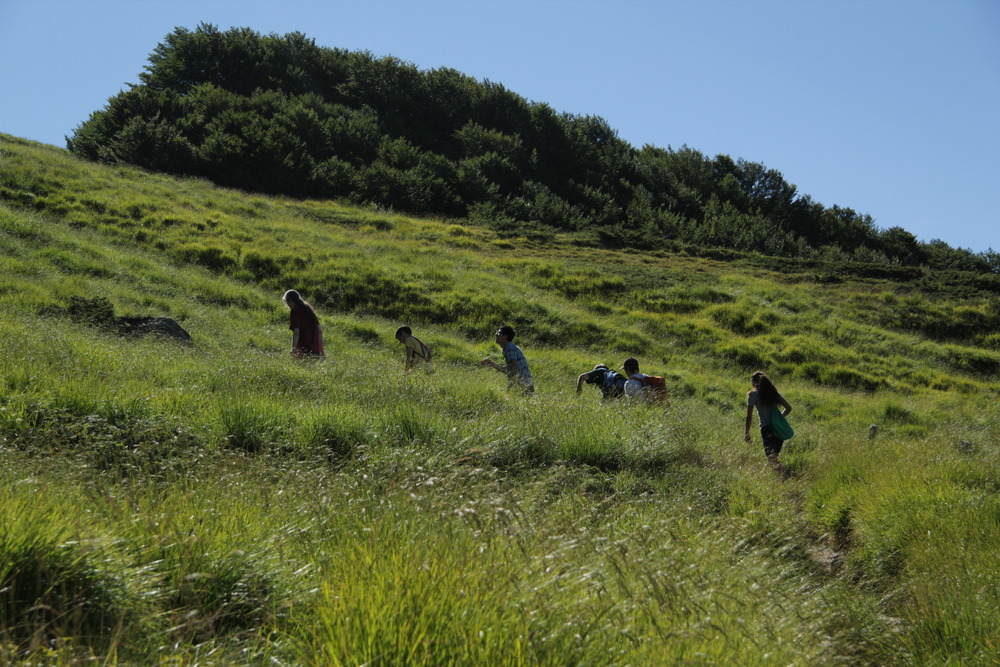
Comments
- “I just wanted to say thanks a lot for again organizing the coolest conference of the universe (only small furry creatures from Alpha Centauri could disagree)!” [Sure, but why would they disagree..?? MDT]
- “Thanks again for working so hard to have a wonderful workshop in Vallico Sotto. There is simply nothing else like it!”
- “Thank you so much for the two amazing weeks in Vallico. I will never forget those moments.”
- “It was so great coming to the workshop and getting to know you and your family a little. You are doing great stuff! Maybe in the future I can come longer and help out some.”
- “It was lovely to see you, Sam, Saska & Jamie, your home and to have a chance to catch up. Thank you for inviting me and for being such gracious hosts.”
- “Thanks for a good TTI, even the rain was pleasantly tuscanic… Please thank Sam and the kids for having us all, and hope the summer school went well.”
- “We left in a rush on Friday and I did not have time to thank you again for your hard work in putting together such an excellent event. I enjoyed myself as much as every other year (despite the weather!), and found it one of the most useful conferences I attend every year. Enjoy the summer school!”
- “Thanks again for a great conference and I hope the summer school goes well, too!”
- “Thank you again for organising everything. This was a great meeting!”
- “Thank you very much for your efforts. I really enjoyed the
conference!”
- “Thank you very much for your great workshop.”
- “Thanks for organizing the conference and accommodating my special
arrangements. As ever, it was very good fun and I was sad to leave
early.”
- “Thank you again for the invitation, the hospitality and all the conference organisation. I had a great time there.”
- “Thanks again for organizing the very nice conference.”
